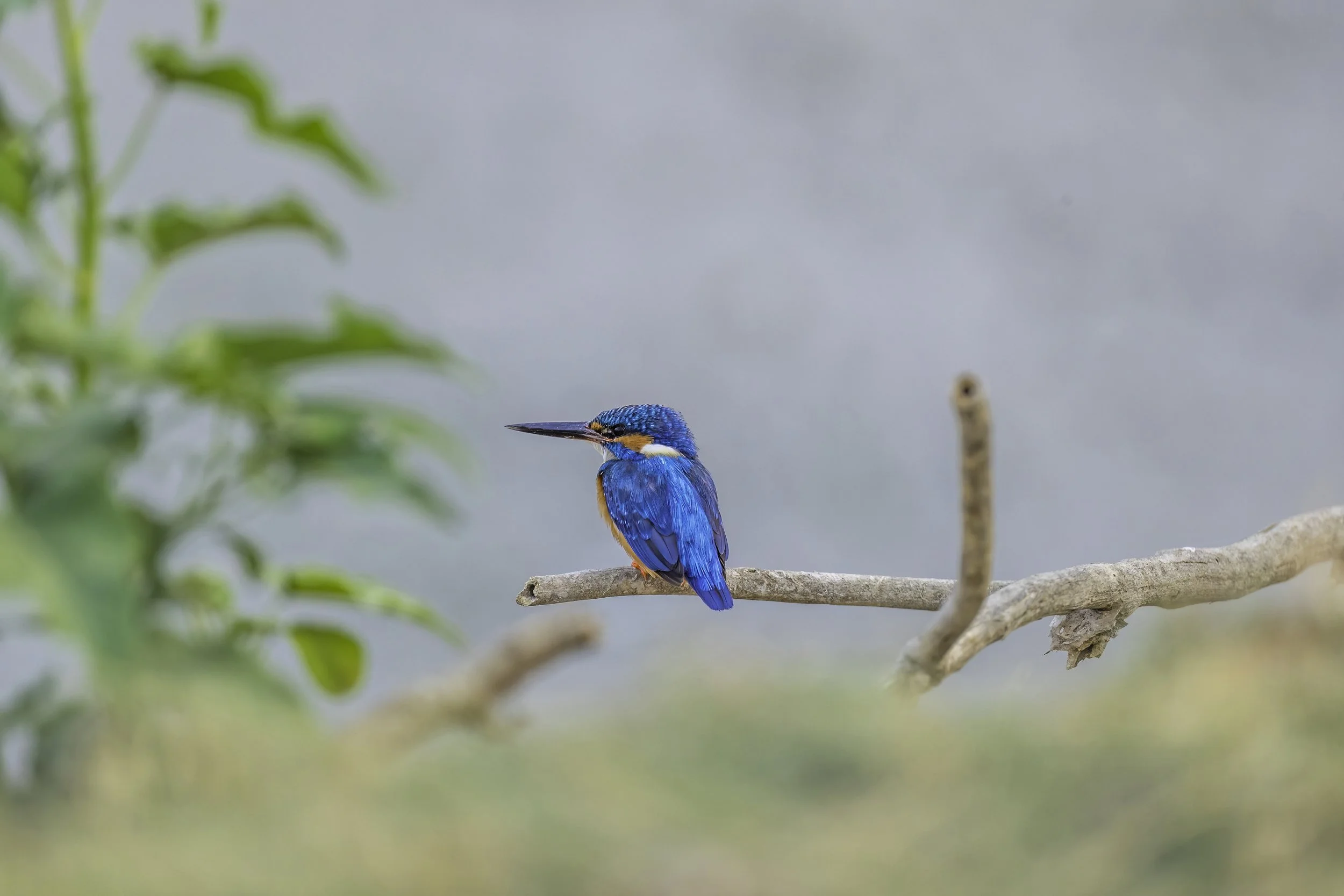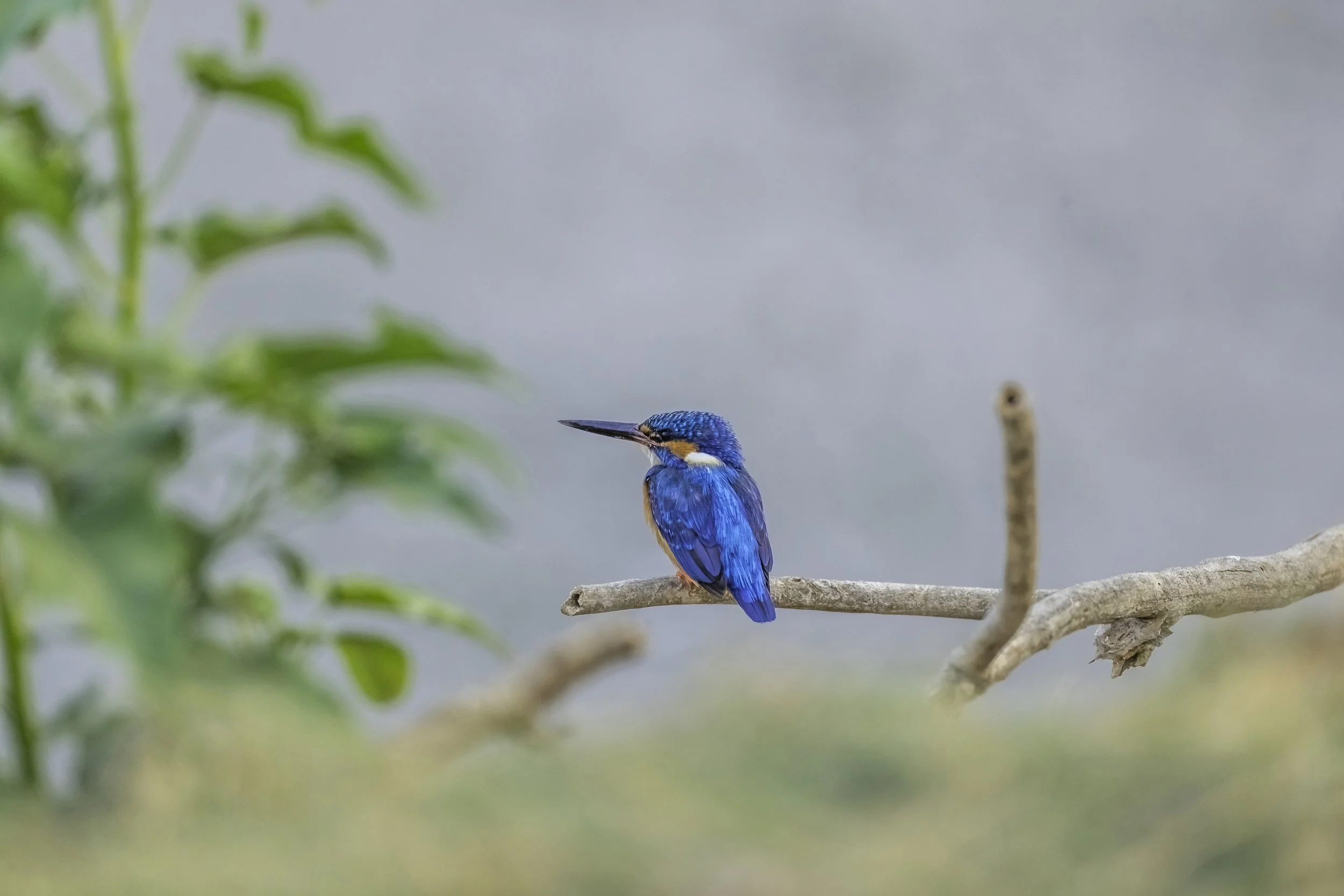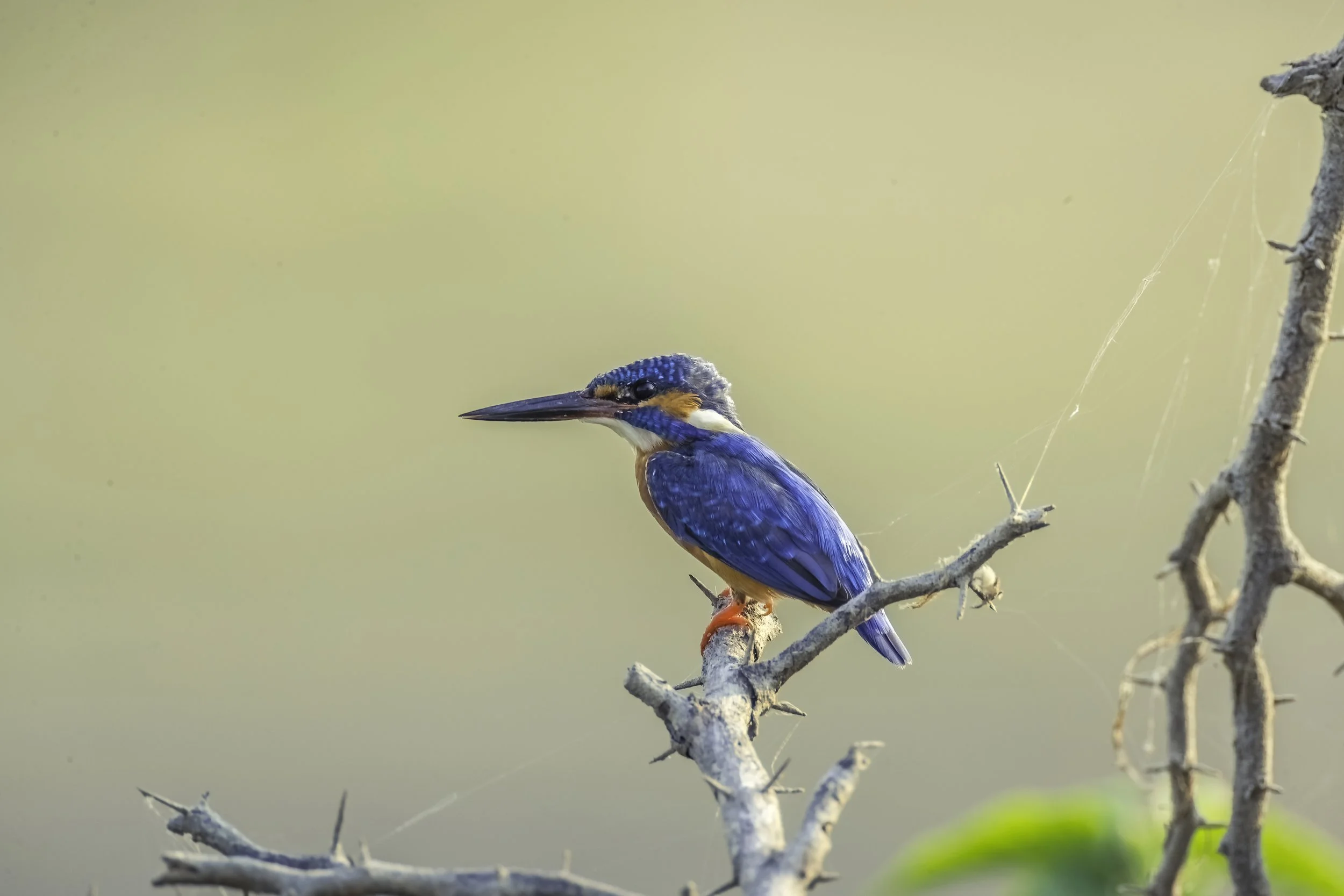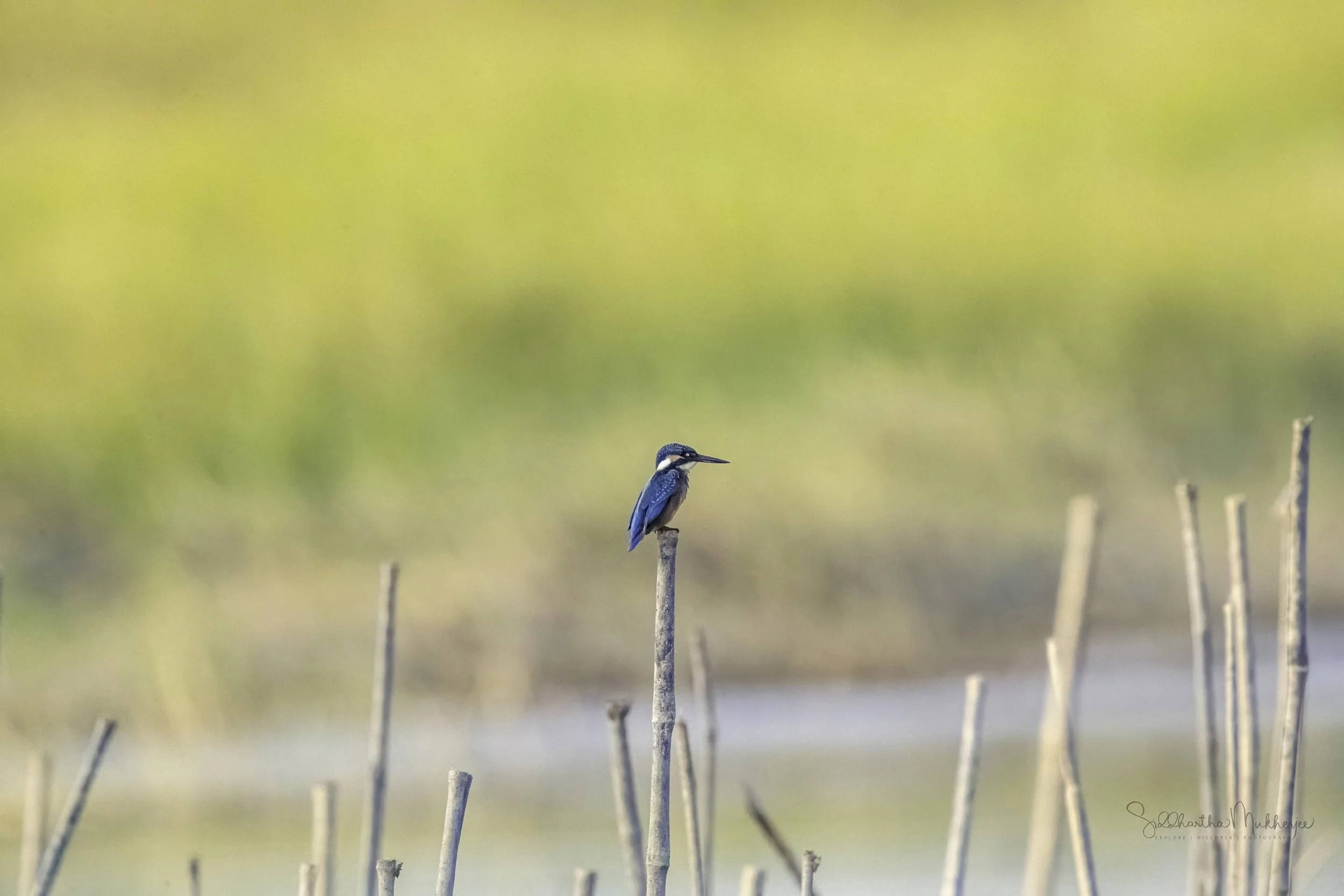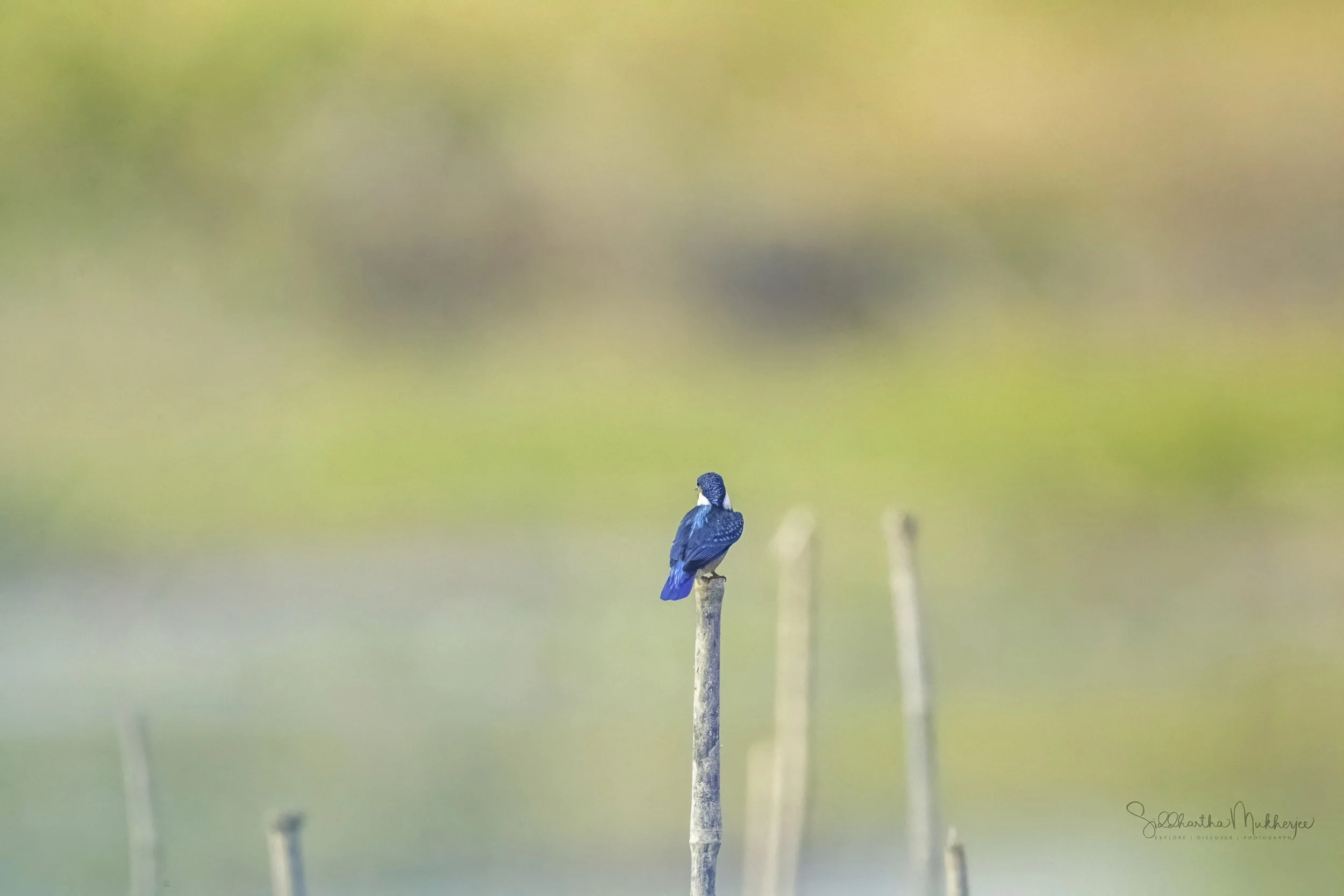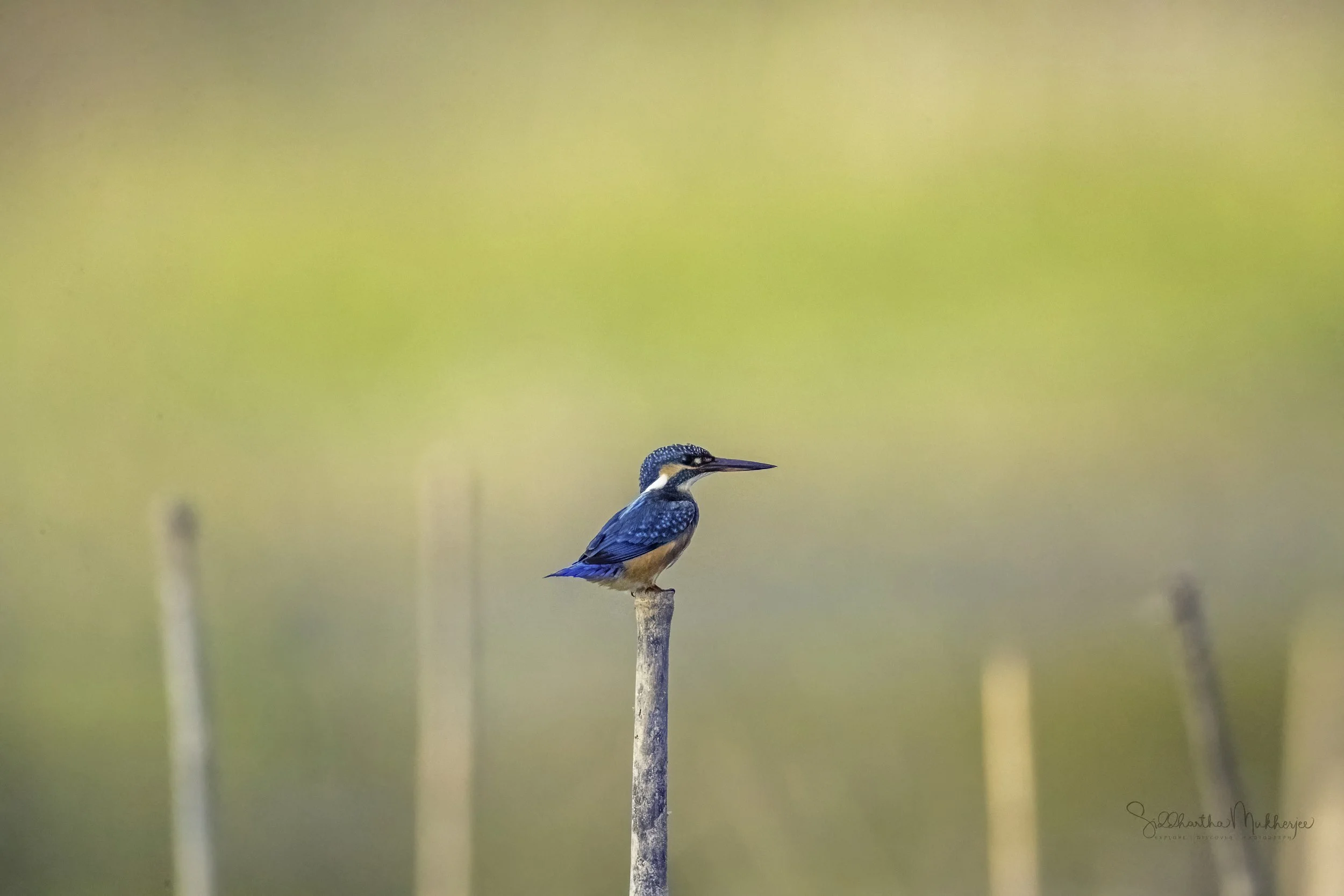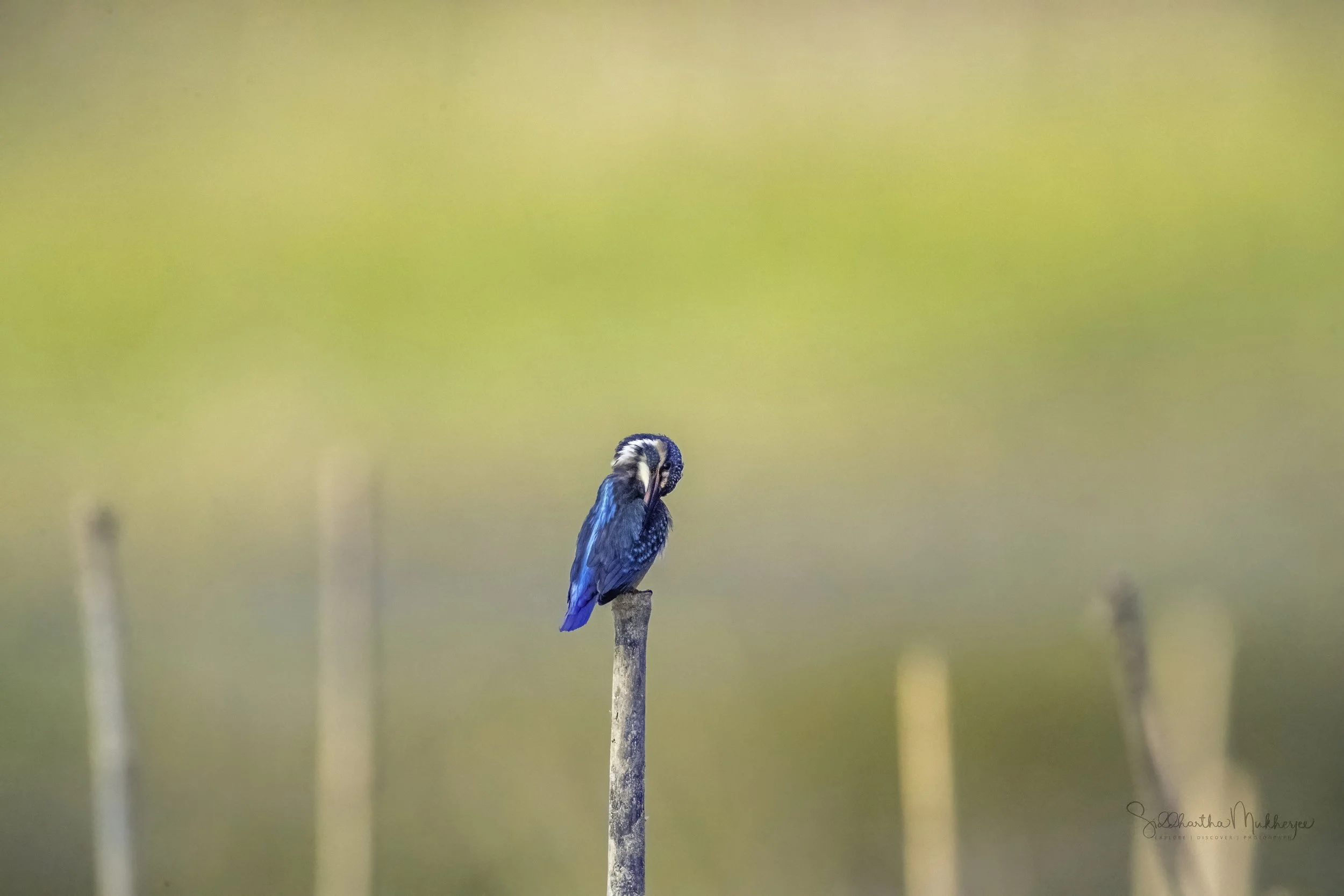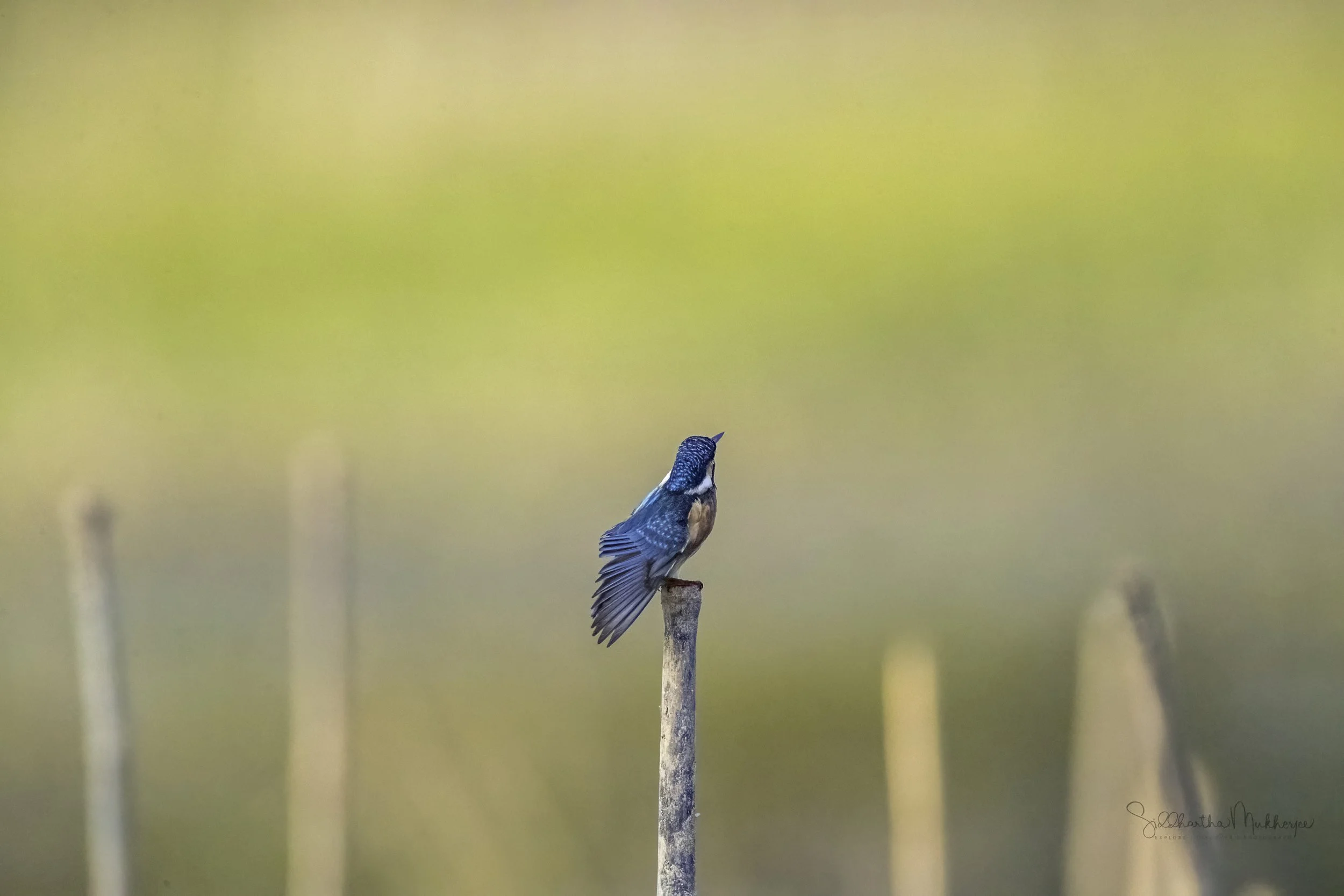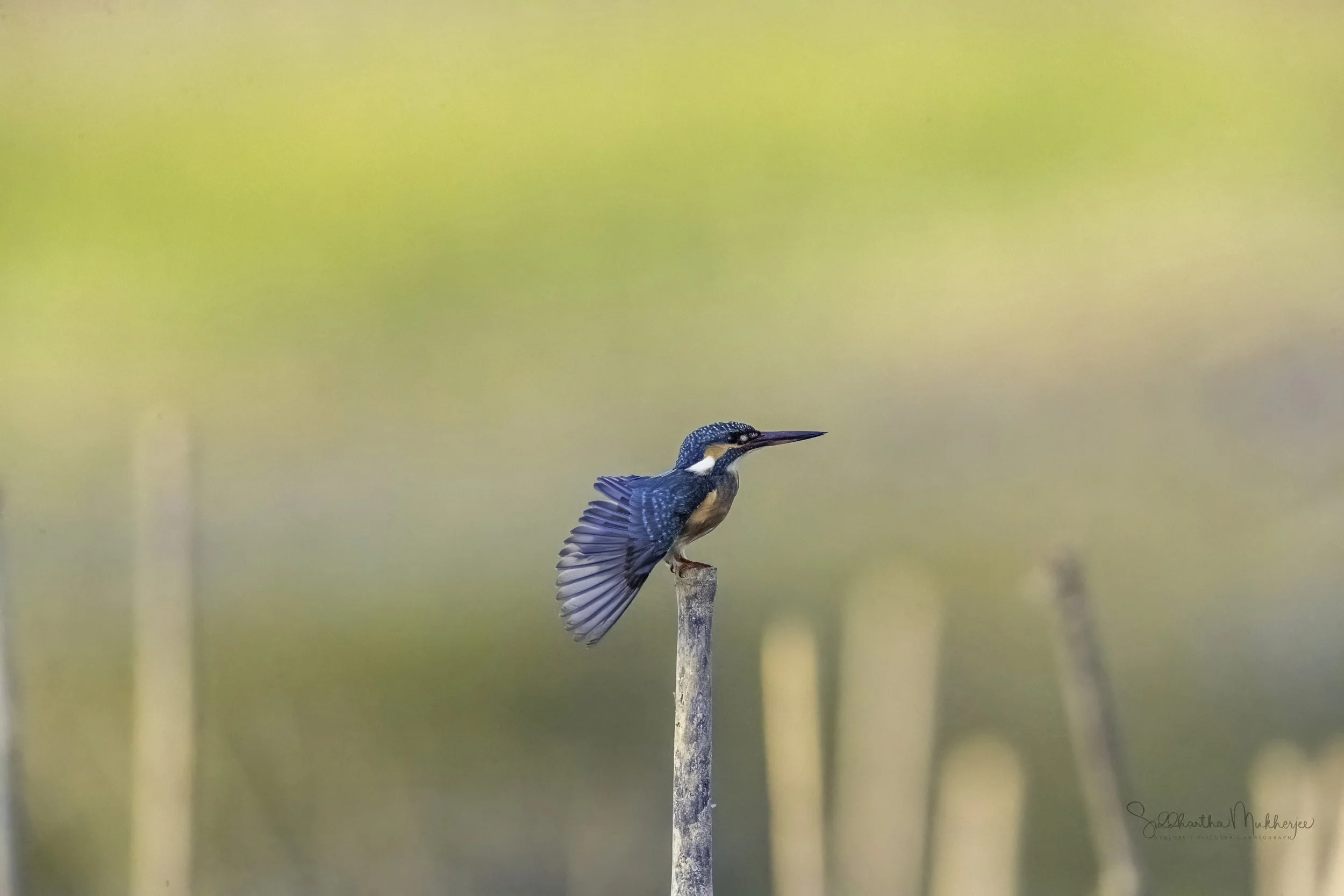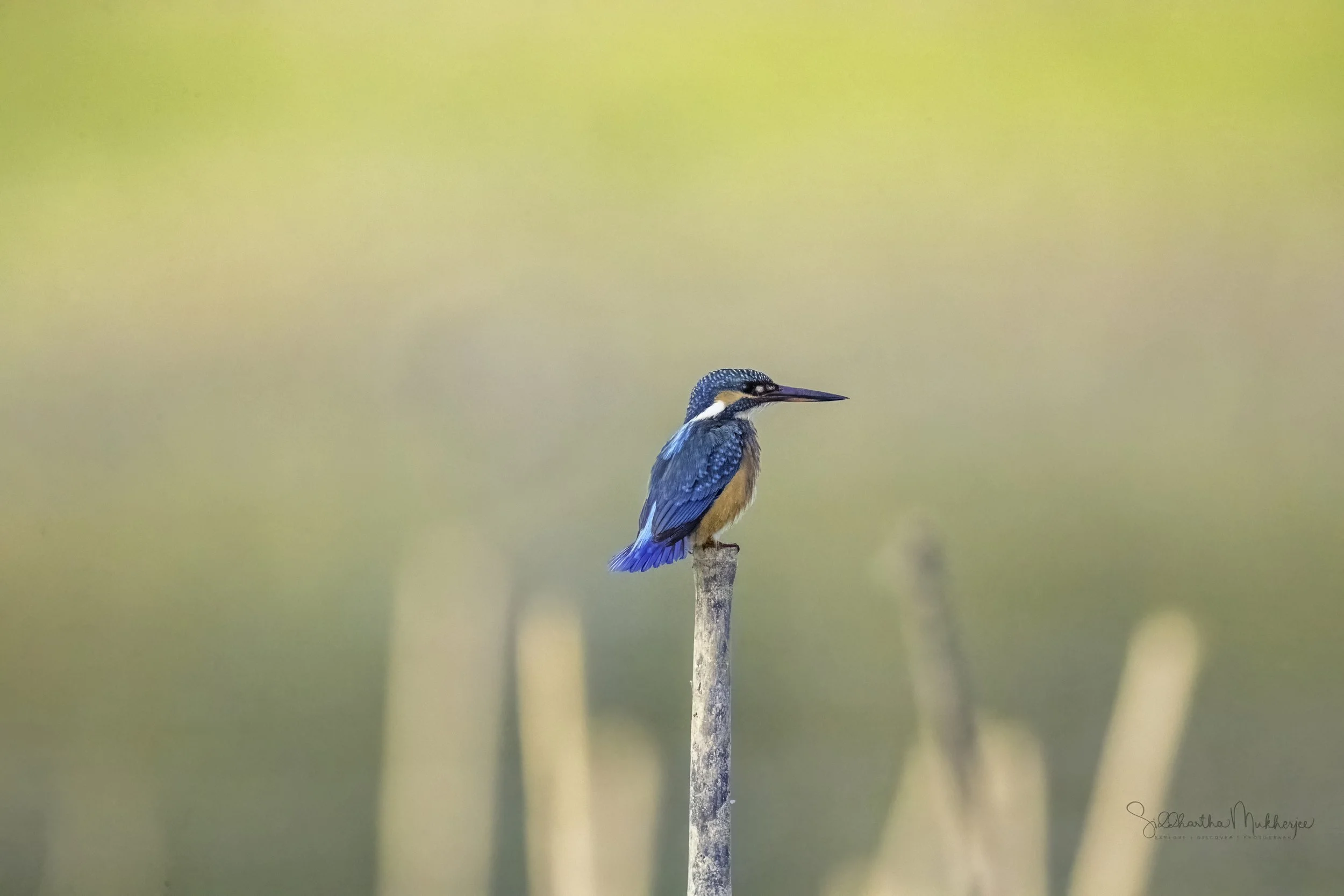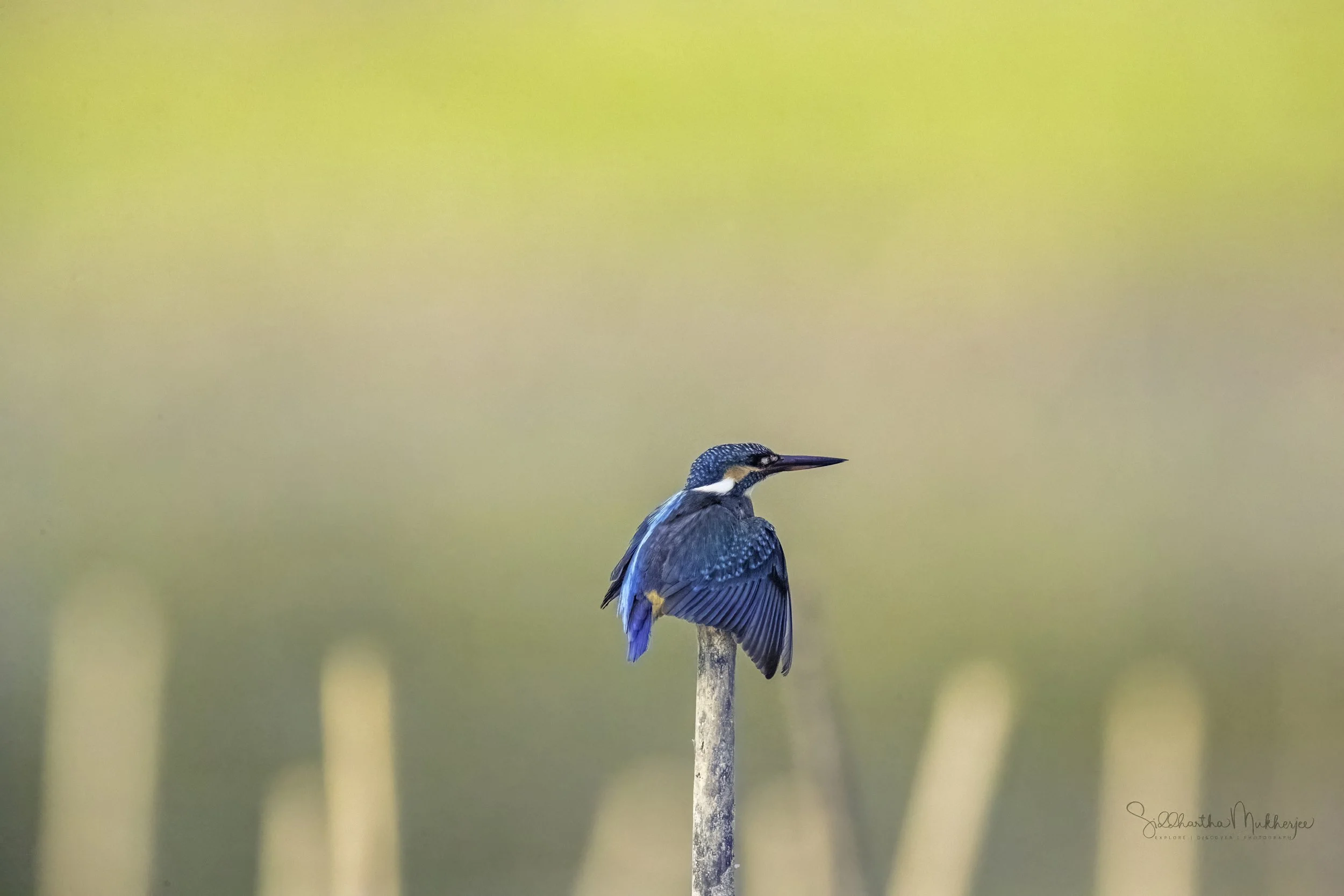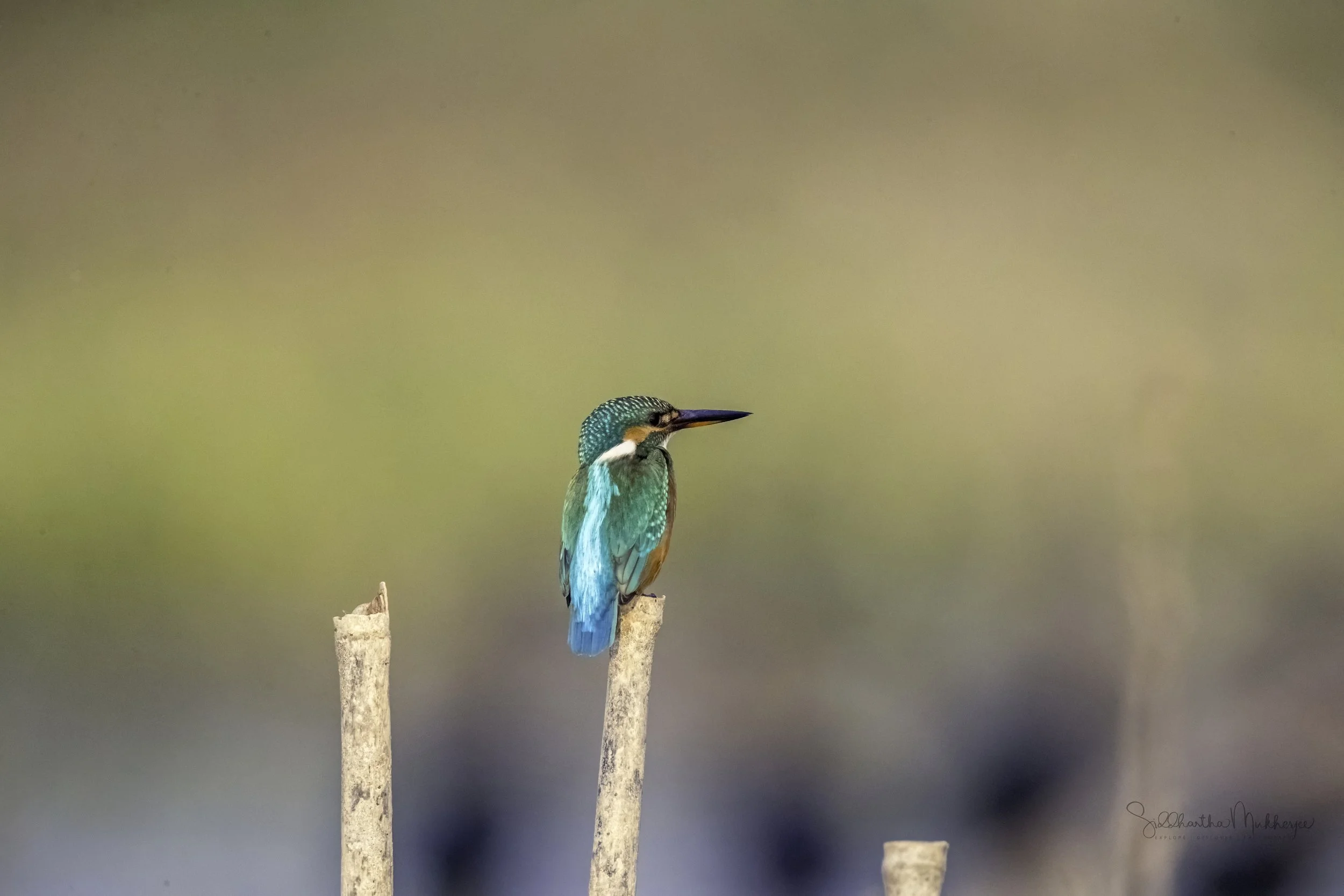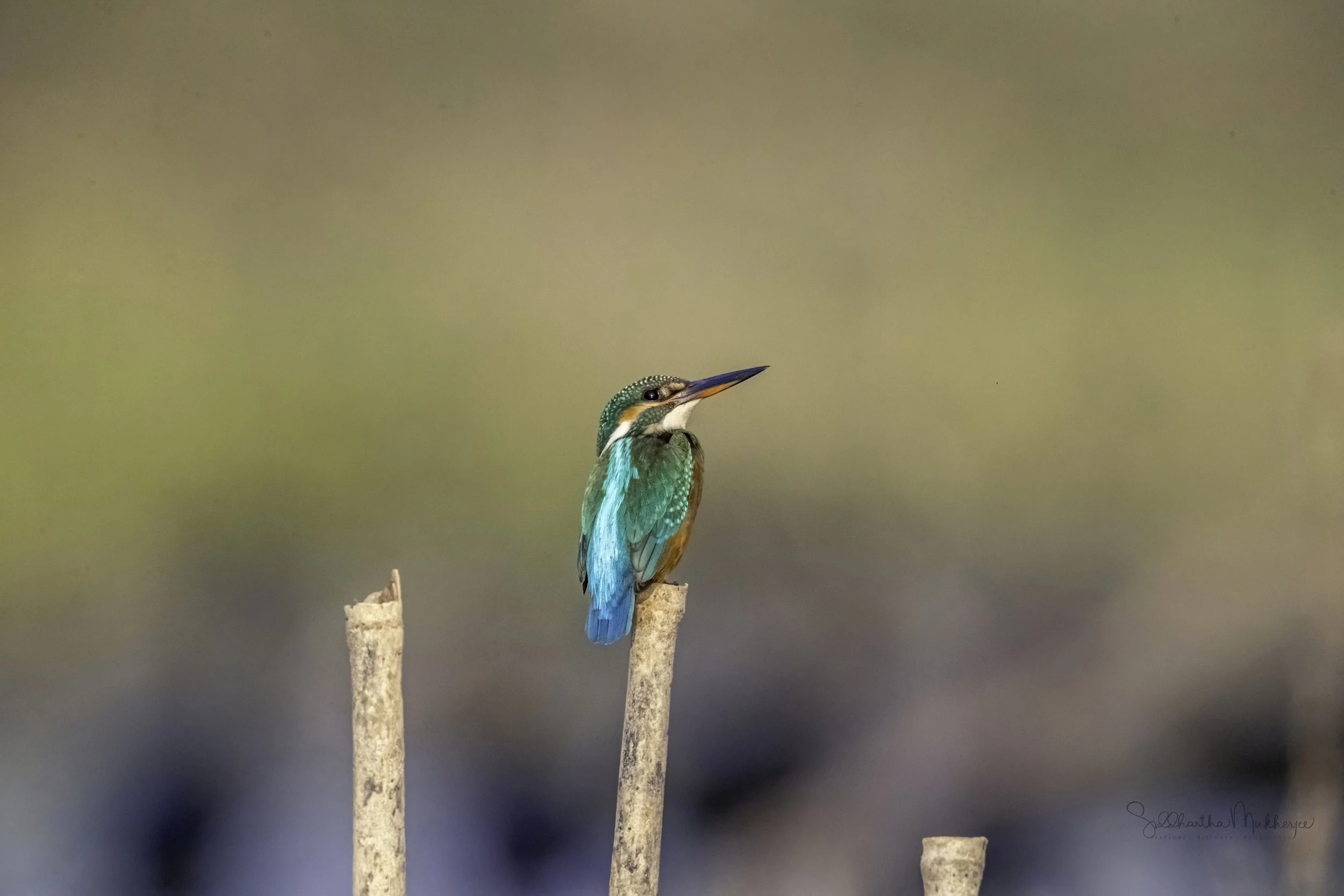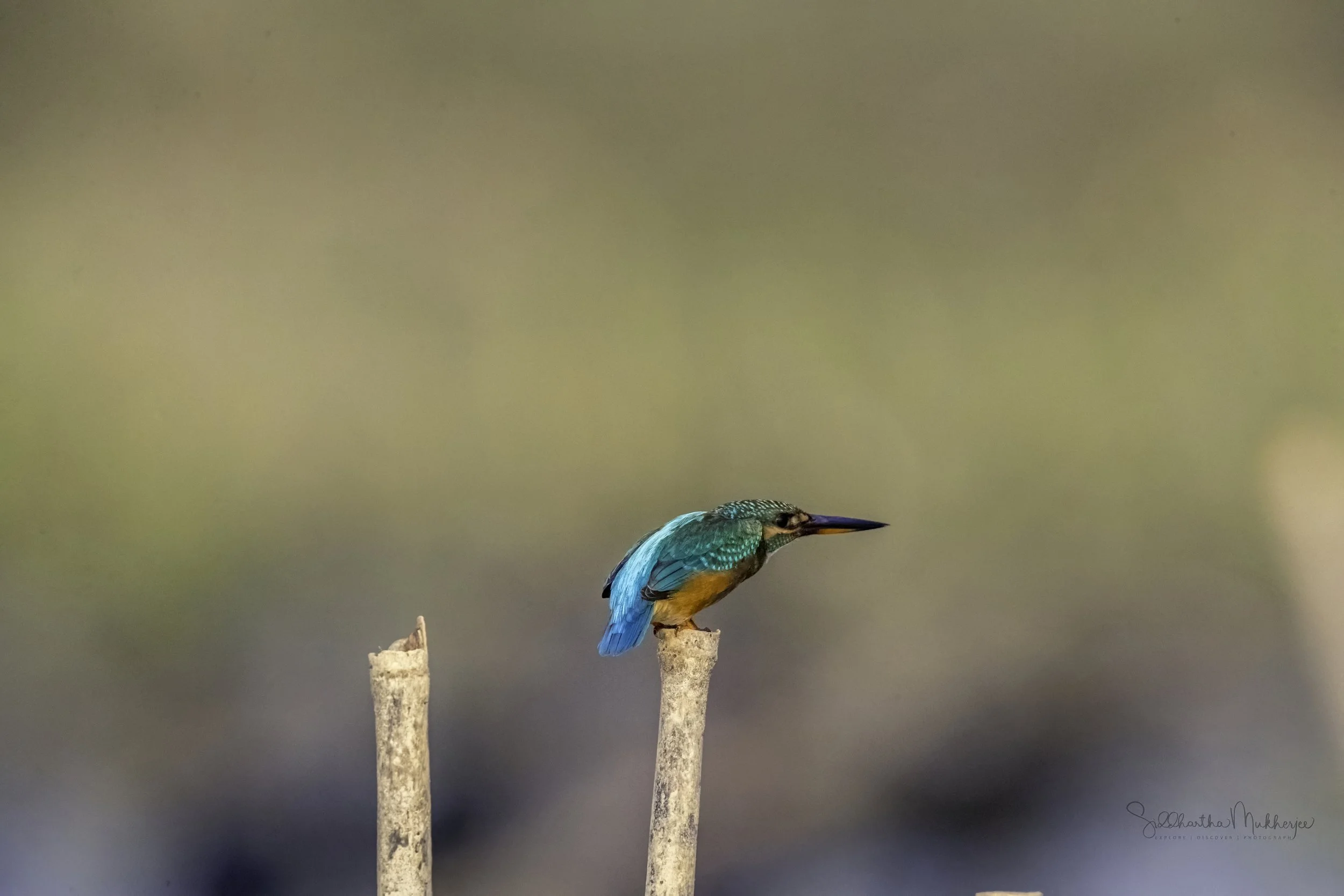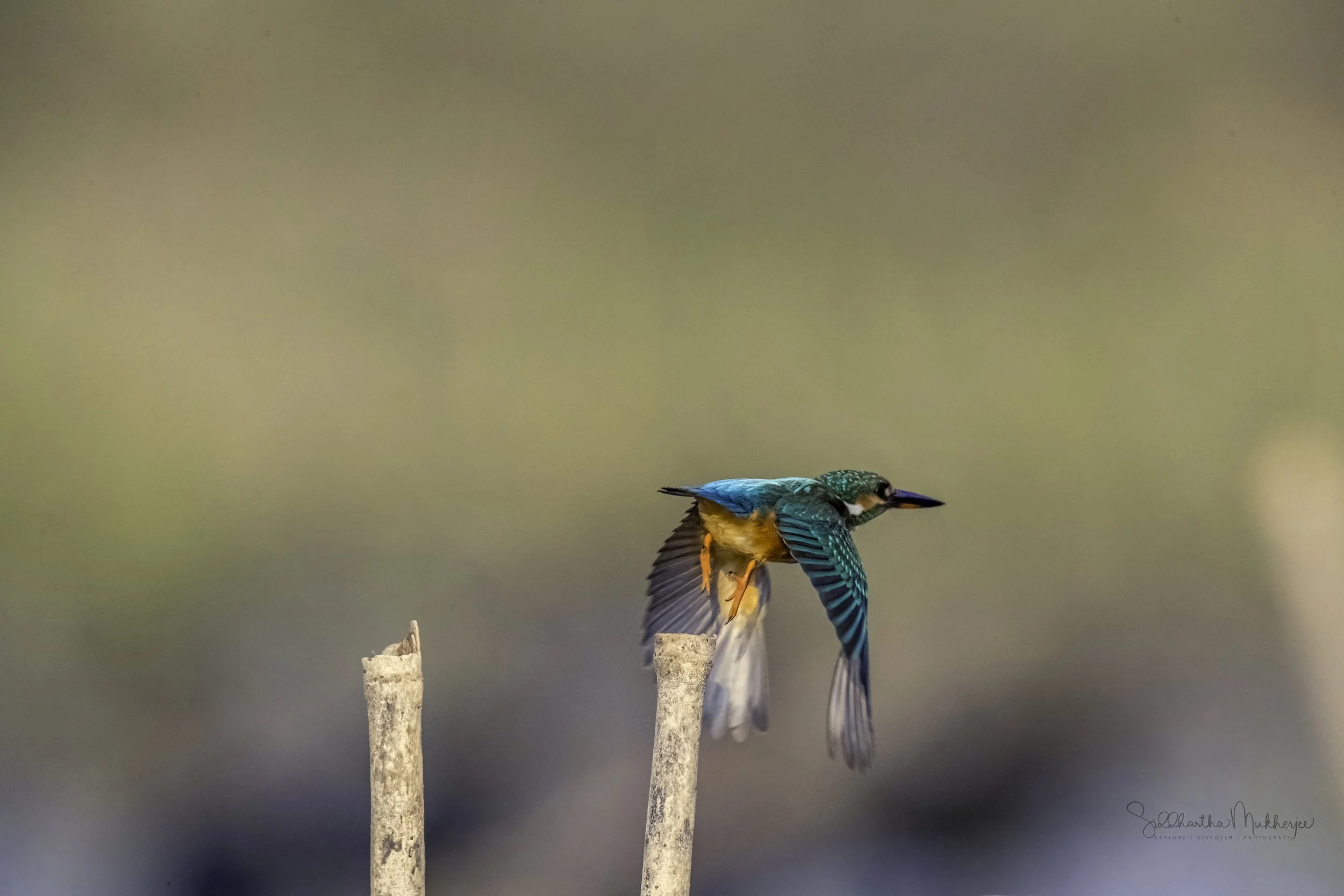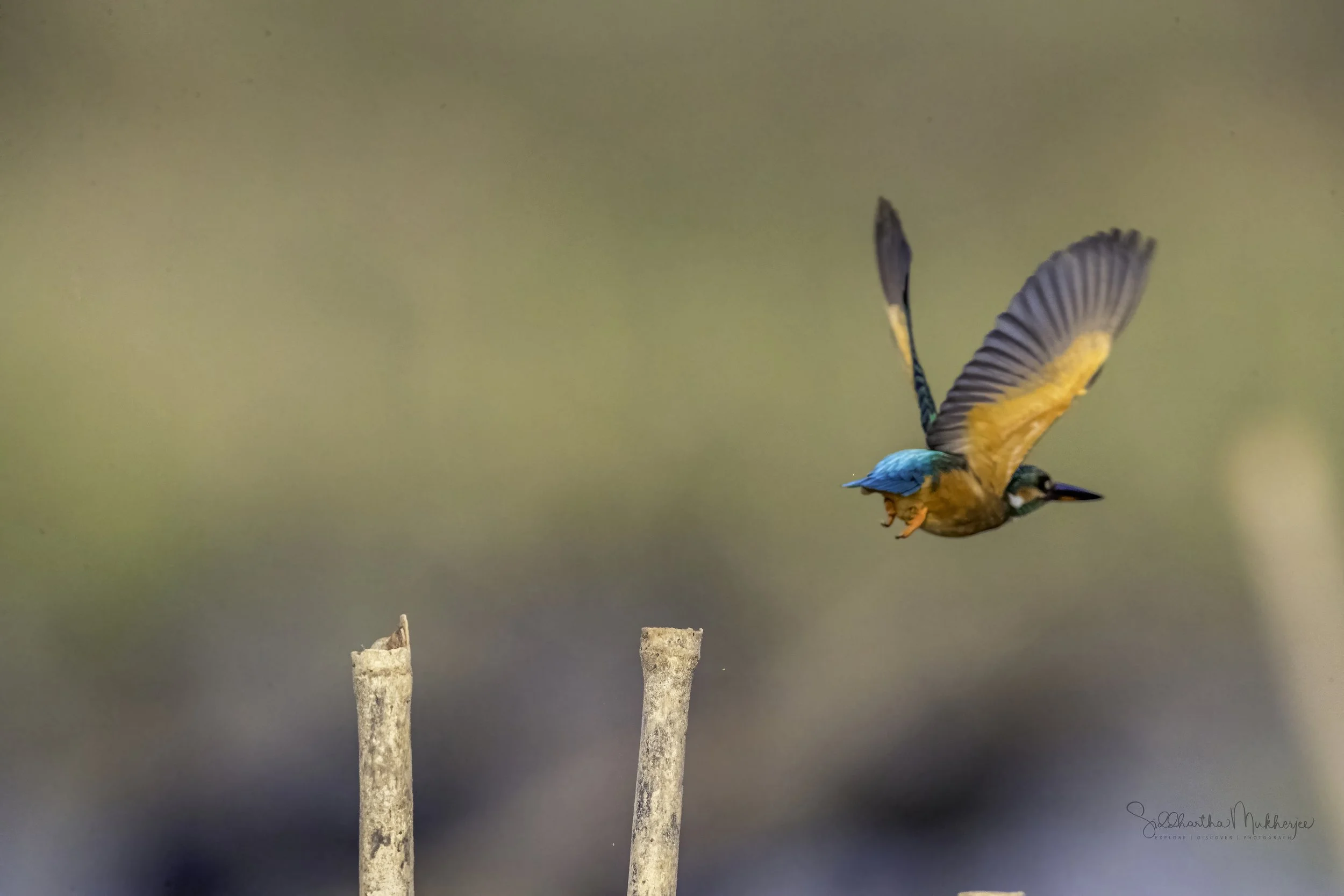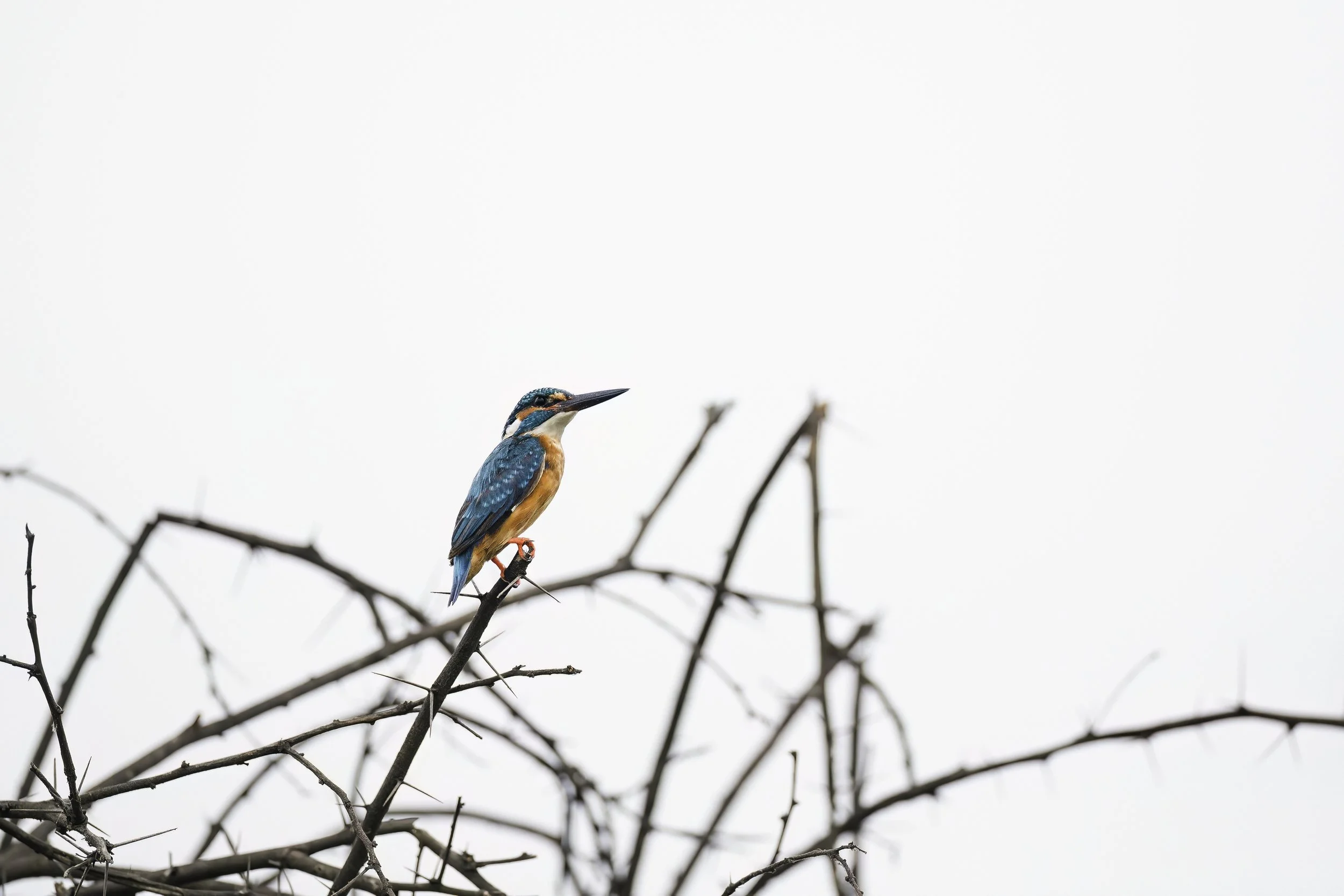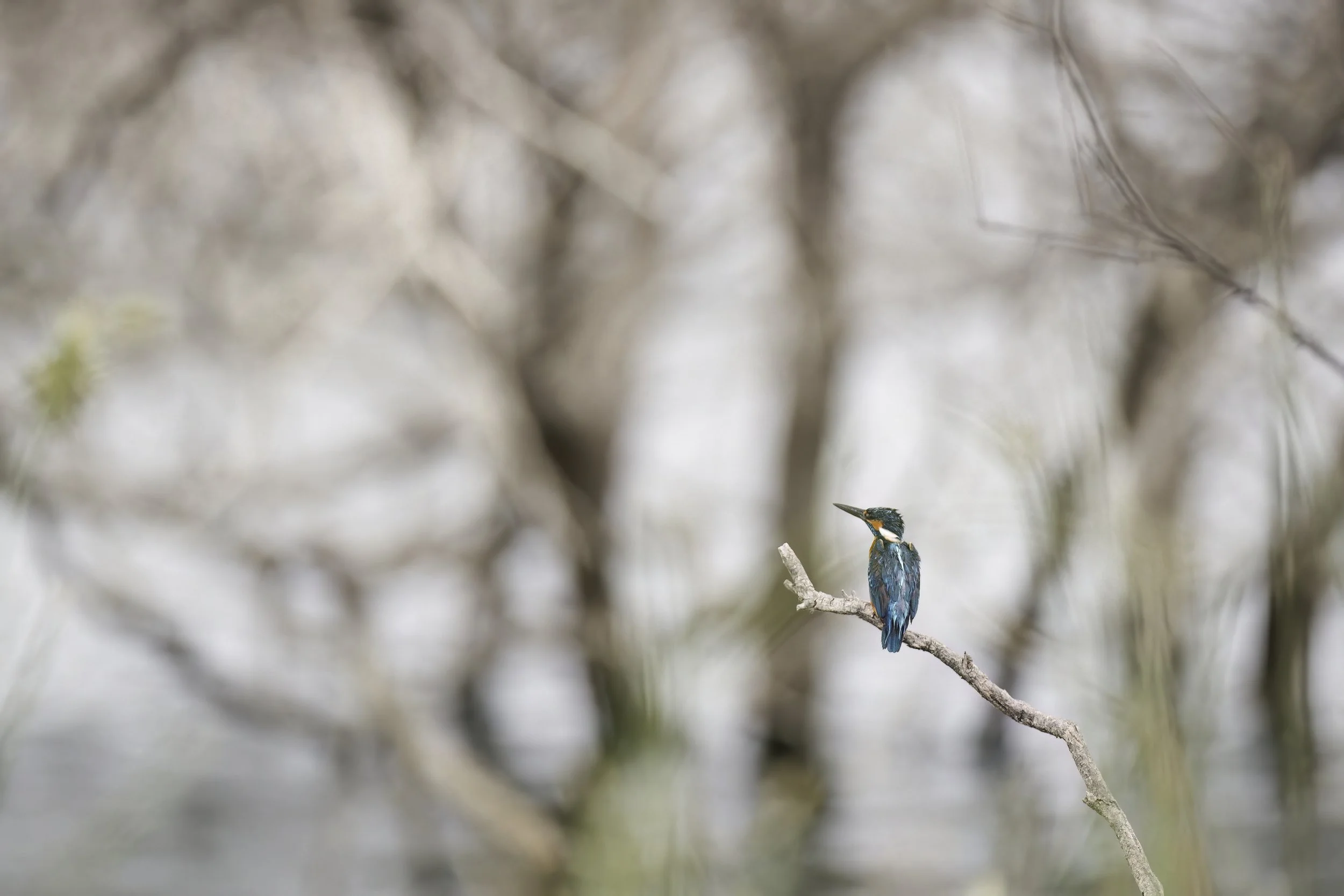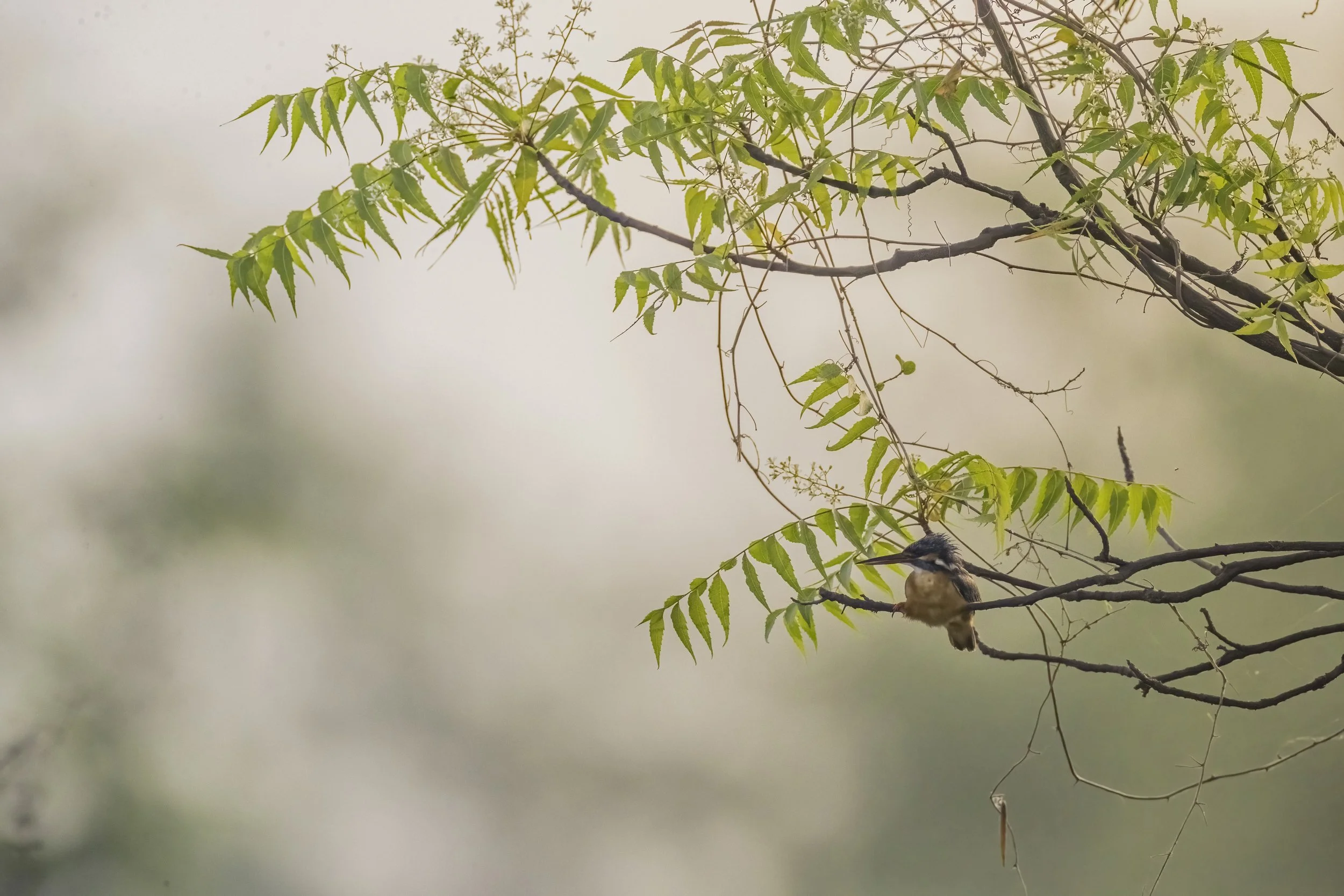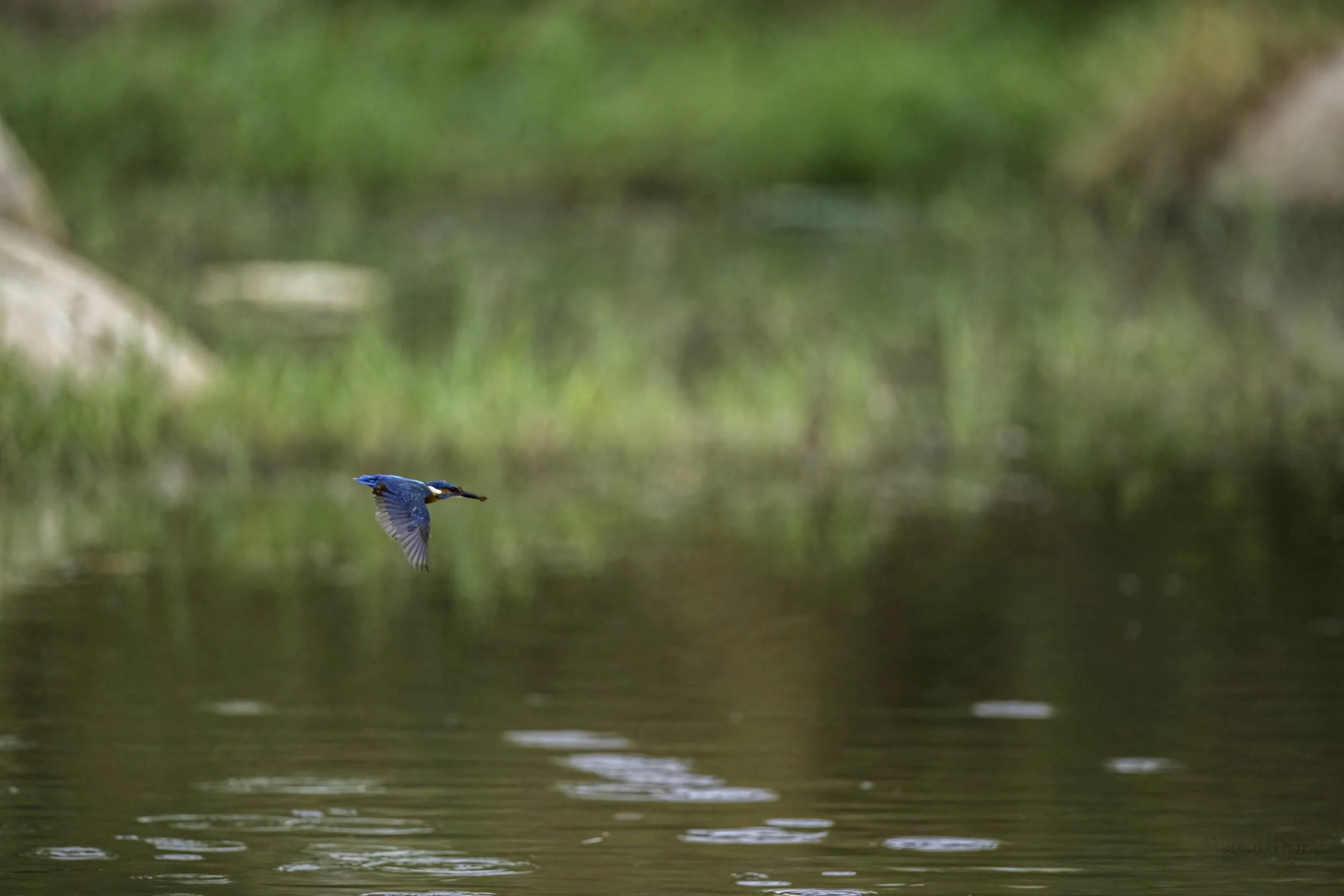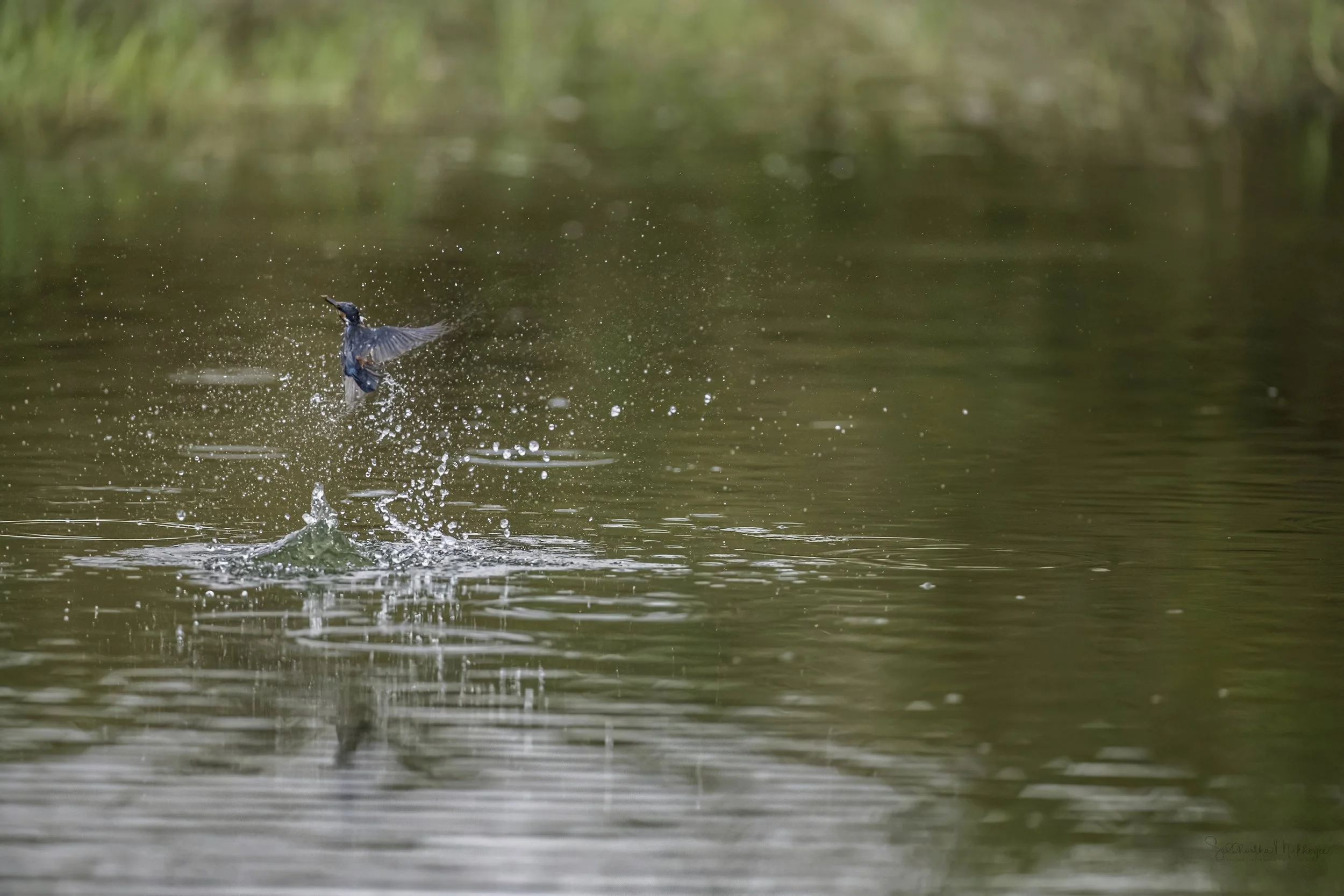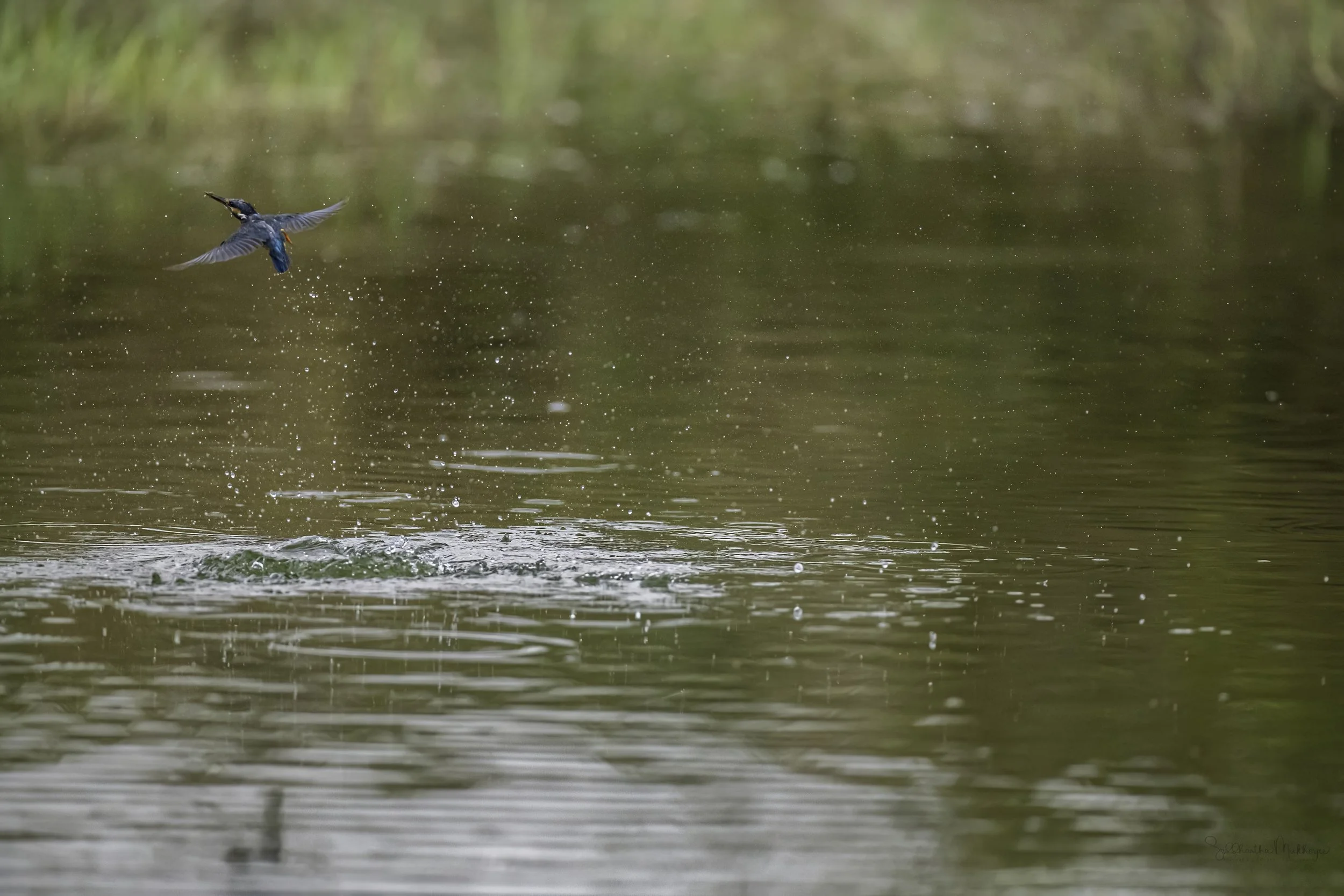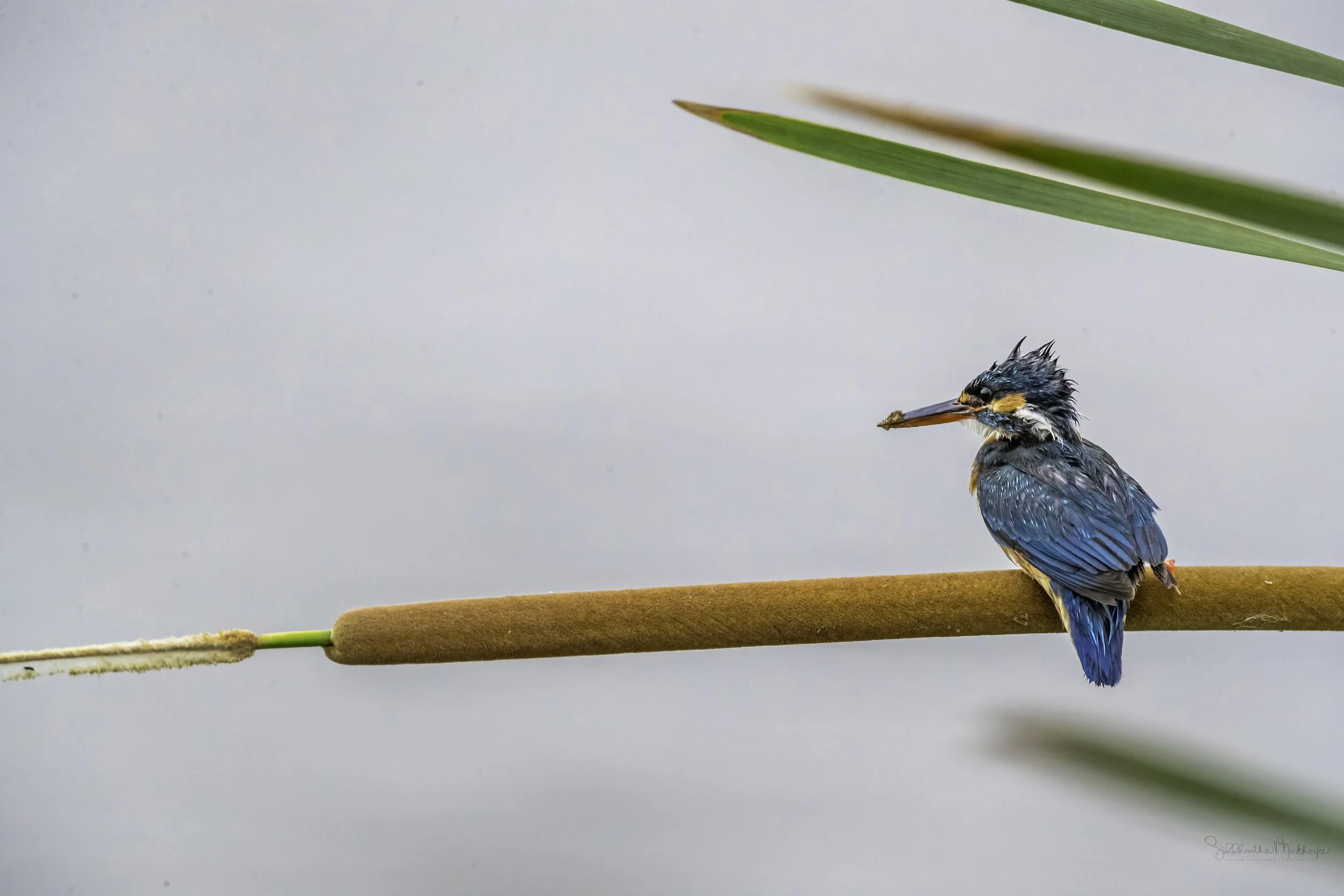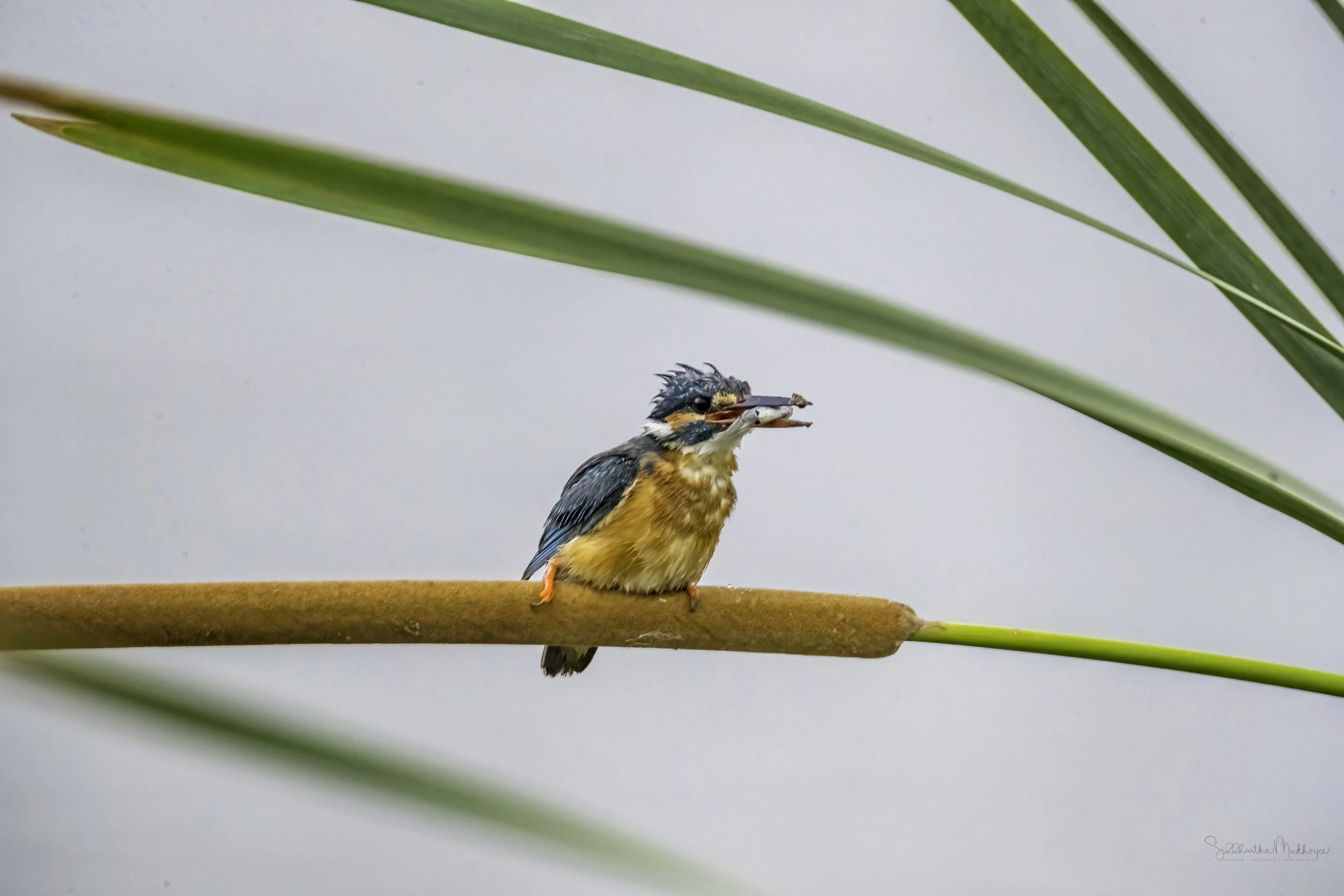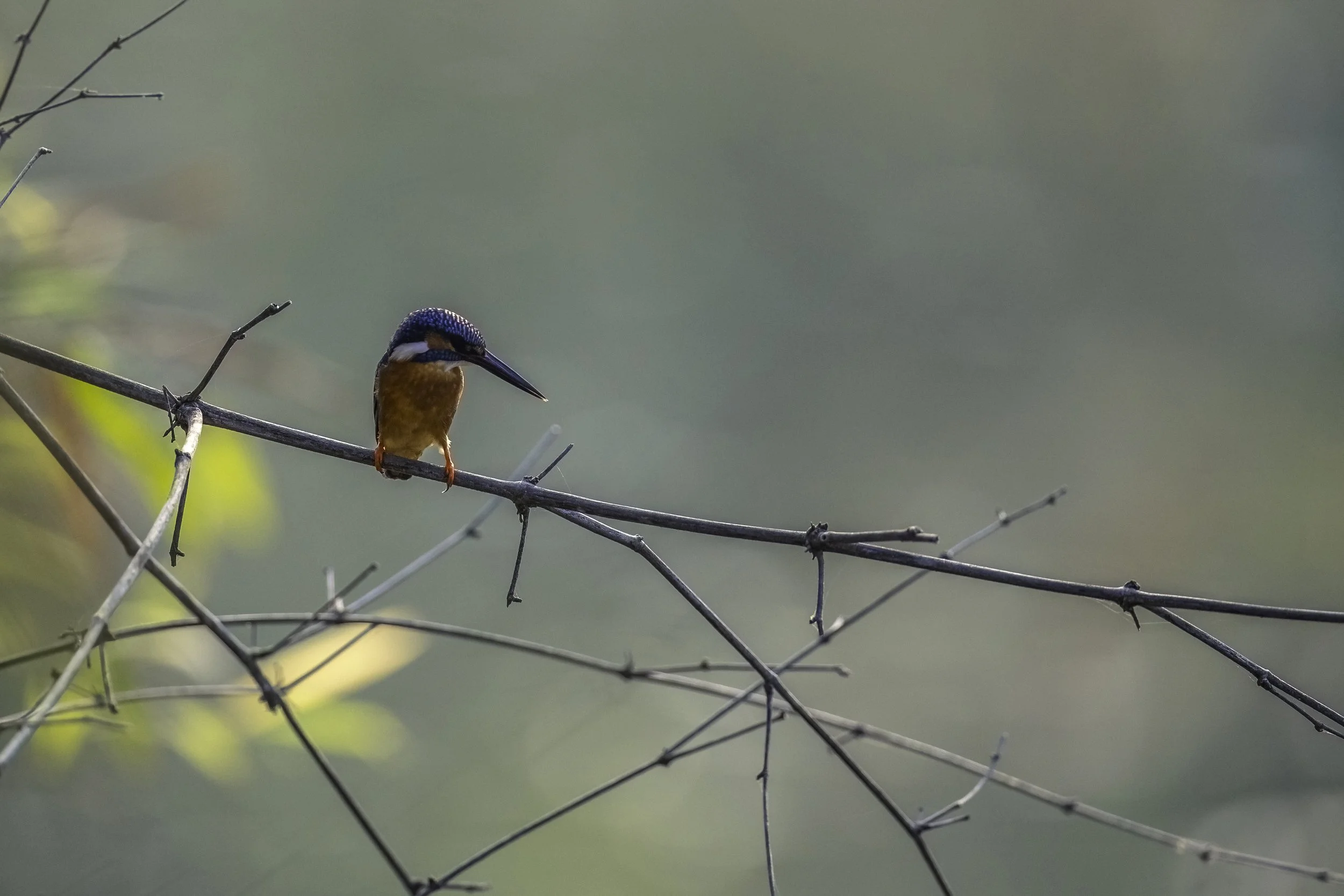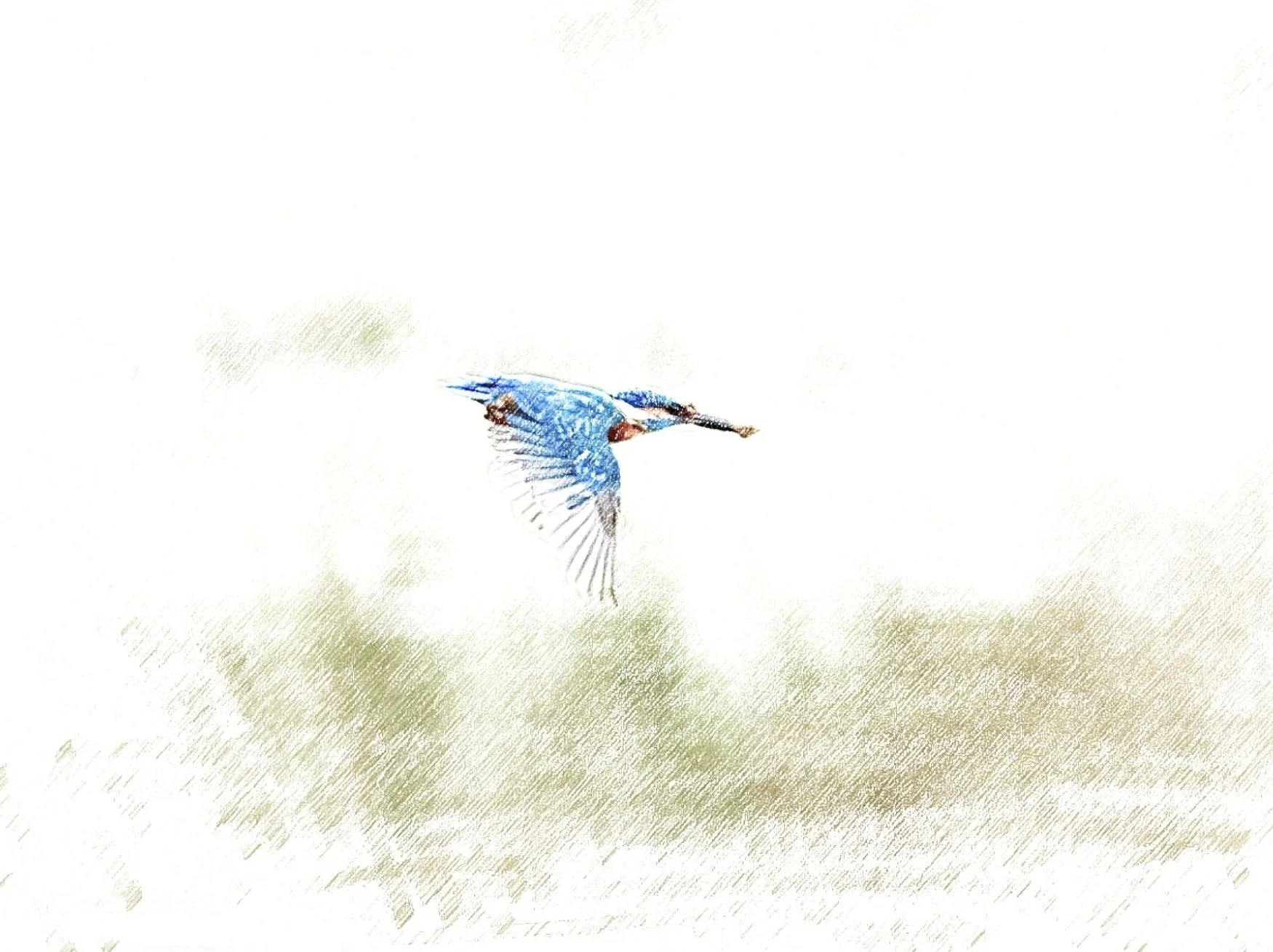Common Kingfisher
Alcedo atthis
Lakes of Telangana like the Ammavaripeta Cheruvu & Ameenpur Lake
After another long hiatus I am continuing the story of kingfishers from my earlier three part series, A clique of Kingfishers, today I have another one from that list of beautiful birds - the Common Kingfisher or the Small Blue Kingfisher. The Common Kingfisher is a beautiful little blue-and-orange bird with a long, pointed bill often rather shy and inconspicuous despite its bright plumage. Found along rivers, streams, lakes, and ponds—almost any fresh or brackish habitat with small fish it often perches quietly in trees over water; most often seen in very fast low flight as a turquoise flash over the water, usually flying away. It is easily detected once its high, shrill whistled call is learned, even if the bird itself is hidden. It is the only small blue kingfisher over much of its range.
The Kingfishers or Alcedinidae are a family of small to medium-sized, brightly coloured birds in the order Coraciiformes. They have a cosmopolitan distribution, with most species found in the tropical regions of Africa, Asia, and Oceania. The family contains 114 species and is divided into three subfamilies and 19 genera.
Kingfisher Distribution
All kingfishers have large heads, long, sharp, pointed bills, short legs, and stubby tails. Most species have bright plumage with only small differences between the sexes. The kingfishers have a cosmopolitan distribution, occurring throughout the world's tropical and temperate regions. They are absent from the polar regions and some of the world's driest deserts. A number of species have reached islands groups, particularly those in the south and east Pacific Ocean. Most species are tropical in distribution, and a slight majority are found only in forests. They consume a wide range of prey usually caught by swooping down from a perch. While kingfishers are usually thought to live near rivers and eat fish, many species live away from water and eat small invertebrates. Like other members of their order, they nest in cavities, usually tunnels dug into the natural or artificial banks in the ground. Some kingfishers nest in arboreal termite nests.
A number of species are considered threatened by human activities and are in danger of extinction. The majority of these are forest species with limited distribution, particularly insular species. They are threatened by habitat loss caused by forest clearance or degradation and in some cases by introduced species.
Kingfishers are generally shy birds, but in spite of this, they feature heavily in human culture, generally due to the large head supporting its powerful mouth, their bright plumage, or some species' interesting behaviour. For the Dusun people of Borneo, the Oriental Dwarf Kingfisher is considered a bad omen, and warriors who see one on the way to battle should return home. Another Bornean tribe considers the Banded kingfisher an omen bird, albeit generally a good omen.
I have been able to photograph a few of these beautiful kingfishers from all across Asia Pacific with some coming quite easily and some coming after waiting for hours, damp and cold but worth every bit the wait. In A clique of Kingfishers, I featured 9 species, presented in three parts, some easily seen and some rare, threatened and critically endangered.
Continuing to expand within that list I have here the Common Kingfisher, also known as the Eurasian Kingfisher, River Kingfisher & Small Blue Kingfisher. It is a small kingfisher with seven subspecies recognized within its wide distribution across Eurasia and North Africa. It is resident in much of its range, but migrates from areas where the rivers freeze in the winters.
The first time I photographed these beautiful birds was at the Little Rann of Kutch in January 2018 - one individual had perched a couple of feet away from me as I waited on the numerous eagles of the Rann. All I had at the time was the Canon 7D Mark ii and the excellent EF 100-400mm lens.
From then to now has been quite a journey.
The following video & photos are but a snapshot of the beautiful time spent with these Common Kingfishers. The video is best experienced in 4k for the exquisite iridescence of the feathers.
‡‡‡‡‡
Ammavaripeta Cheruvu is a small lake some kilometers away from the ancient city of Warangal, the erstwhile capital of the Kakatiyas. It is one of the few unpolluted lakes in the area. Located about 1.5 km from the ancient Kakatiya capital of Warangal and 3 km from the town of Kazipet, surrounded by lush green fields, the lake was constructed in AD 1213 by the Kakatiya king Ganapati Deva. The lake lies in the precincts of the village of the same name falling in the Hanamkonda Mandal in the Warangal district. A peaceful village, its claim to fame is the Sammakka Saralamma Jatara, a tribal Hindu festival to honour the tribal goddesses. Held every two years to honour the goddesses Sammakka and her daughter Sarakka (also called Saralamma), it is the time for the largest tribal congregation in the world with approximately 10 million people converging on the site over a period of 4 days. The devout offer Bellam (jaggery), locally called Bangaram (gold), to the deities. The jatra begins at the remote village of Medaram in Tadvai Mandala in the Mulugu district, deep in the Etunagaram Wildlife Sanctuary, one of the oldest sanctuaries of Telangana, and a part of Daṇḍakāraṇya - the largest surviving forest belt in the Deccan and mentioned in the epic Rāmāyaṇa. All rituals to the goddesses are performed by the priests of the forest dwelling Koya Tribe (Koitur in Koya Bhasha) in accordance with their customs and traditions. This intangible cultural heritage of Telangana is believed to attract the largest number of devotees in the country after the Kumbha Mela.
There are many legends about the miraculous powers of Sammakka. According to a 13th-century tribal legend, some tribal leaders on a hunt found a newborn girl (Sammakka) enveloped in light playing amidst tigers. They took her to the tribal chief, who adopted and raised her as a leader. She later became the saviour of the tribals in the region. She was married to Pagididda Raju, the tribal chief of the Koyas. Medaram was ruled by the Kakatiyas from their capital in Warangal between 1000-1323 AD. Sammakka had two daughters and one son, Sarakka alias Saralamma, Nagulamma, and Jampanna. King Prataprudra of the Kakatiyas imposed taxes on the Koya Tribe, which they could not pay. As a result, King Prataprudra declared war on the Koya Tribe. Pagididda Raju was killed in the ensuing battle forcing the grief-stricken Sammakka to pick up the fight with her daughter Saralamma, her son Jampanna, and her son-in-law Govinda Raju. Sammakka had almost won when Saralamma died in the battle. Jampanna was mortally wounded and fell bleeding into Sampangi vaagu (stream). Legend has it that the stream, a tributary of the mighty Godavari, turned red from the blood, and the stream was renamed "Jampanna Vaagu" in honour of Jampanna's sacrifice. Distraught, Sammakka retired to a hill called Chilakala Gutta and turned into a turmeric jar (kumkuma bharani) filled with kumkuma powder. After the battle, Sammakka and Saralamma were deified and a festival or jatra was organised in their honour once every 2 years. To this day, the Koya tribe and devotees believe that Sammakka and Saralamma are manifestations of Adi Parashakti (the Supreme Goddess in Hinduism - Mahadevi as the Mulaprakriti (Primordial Goddess) is described having five primary forms — Durga, Lakshmi, Saraswati, Gayatri and Radha) sent to protect them. The jatra is a celebration to honour their sacrifice. The kumkuma jar is brought to Medaram and people wash themselves in Jampanna Vaagu, followed by an offering of Bellam or jaggery to Sammakka and Saralamma.
Several communities in Telangana society support the jatra as it is a “mythical” narrative of two tribal women leaders who rebelled against the Kakatiya rulers trying to annex their land and forests. Legend states it was Sammakka’s curse which eventually caused the gradual decline and eventual demise of the Kakatiya dynasty.
Last year this small lake garnered a lot of attention for having an unusual visitor - the Spur-winged Lapwing. There are many such location across Telangana which are home to migrants and seasonal visitors and every experience of seeing a new bird provides a rush that one can only feel by doing something they love. The local birders and experts also told me that the Ammavaripeta Lake is frequented by many migrants and I think I will continue to visit this pristine lake and document as many as I can.
Ameenpur Lake is a man-made lake reportedly built more than 300 years ago by a courtier, Abdul Qadir Amin Khan of Patancheru, during the reign of Ibrahim Qutb Shah (1550–1580 AD). It was constructed to water his gardens which haven’t survived the ravages of time but the lake itself has, albeit, much smaller in size. The lake is urrounded by fantastic primordial rock formations, modern apartments, factories and a village. In its heyday the lake used to occupy more than 300 acres (1.2 km²), but encroachment and development has reduced it today to a mere 93 acres (0.38 km²). The lake has been divided into two sections, Pedda Ameenpur and Chinna Cheruvu.
The lake is teeming with wildlife, including Bar-headed Geese, Cormorants, Ruddy Shelducks, and Grey Herons. Various resident and migratory birds, such as flamingos, egrets, herons, cormorants, kingfishers, and river terns are among the many local and migratory species that flock to the lake making it a major spot for birdwatchers in Hyderabad. The lake had 186 species in 2016 the time of the last count, up from 171 in 2015. In 2017 it was reported that the lake was home to 8 species of mammals, 166 birds, 45 herpetofauna (12 amphibians and 34 reptiles like the Checkered Keelback & the Oriental Garden Lizard), 9 species of fish, and 143 invertebrates (26 aquatic beetles, 41 butterflies, 18 odonates, 25 arachnids, and 33 other invertebrates). Flamingos are the most common birds found here along with the Oriental Darter, Pallid Harrier, Black-tailed Godwit, Painted Stork, River Tern, and Black-headed Ibis which are among the six species categorised as Threatened on the IUCN Red List. Sometimes, if luck favours, the Greater Spotted Eagle - classified as Vulnerable, and the Egyptian Vulture - classified as Endangered, can be seen soaring the skies here.
Today, because of the vast number of migrating birds that thrive there Ameenpur Lake has the distinction of being the first water body in the country to be declared a Biodiversity Heritage Site. The biodiversity tag was awarded for the Pedda Ameenpur Lake, which is at a higher elevation than Chinna Cheruvu. The Ministry of Environment designated Ameenpur as a Biodiversity Heritage Site in November 2016 under the Biological Diversity Act 2002. It is the first body of water in India to be designated as a Biodiversity Heritage Site, as well as the first biodiversity site to be approved in an urban area.
What is a Biodiversity Heritage Site? These biodiversity heritage sites are a region with great biodiversity that are unique, environmentally fragile ecosystems - terrestrial, coastal, inland and marine waters. They exhibit Species richness including both wild and domesticated species, as well as intra-specific categories. There is a high degree of endemism, rare, endemic, and imperilled species, keystone species, evolutionarily important species, wild forebears of domestic/cultivated species or land races or their variants. There is also predominance of biological components indicated by fossil beds that had cultural or aesthetic value in the past. These sites are important for the preservation of cultural diversity; an area with significant cultural, ethical, or aesthetic characteristics. The State Government, in cooperation with local bodies, may designate sites of biological importance as Biodiversity Heritage Sites under Section 37 of the Biological Diversity Act, 2002.
But that said, there are still threats to this beautiful lake. First the size, it is currently spread over 93 acres which is less than a third of its original 300 acres. This reduction was due to development projects which are still ongoing and may eat into the remaining acreage of the lake. There is also a new cinder block brick kiln that has cropped up on one side. Satellite imagery shows effluents from a chemical factory complex being discharged on the western shores. These discharges along with other industrial pollutants released into the lake has caused a reduction in the food chain of birds such as fish and insects which in turn has led to a reduction in the number of birds visiting the lake. And of course the water itself is unfit for drinking. The number of bird species appears to have decreased, there are fewer trees now, and the lake has a bad odour. The biodiversity tag has the potential to conserve lakes that are otherwise fast disappearing owing to urbanization's effects. This categorization has assisted in the prevention of encroachment and waste dumping. If this lake can be saved, it will serve as an example for other lakes throughout the country.
Common Kingfisher
The Common Kingfisher (Alcedo atthis), also known as the Eurasian Kingfisher, River Kingfisher and Small Blue Kingfisher, is a small kingfisher with seven subspecies recognized within its wide distribution across Eurasia and North Africa. It is resident in much of its range, but migrates from areas where the rivers freeze in the winter. This sparrow-sized bird has the typical short-tailed, large-headed kingfisher profile with blue upperparts, orange underparts and a long bill. It feeds mainly on fish, caught by diving, and has special visual adaptations to enable it to see prey under water. The glossy white eggs are laid in a nest at the end of a burrow in a riverbank.
The Common Kingfisher was first described by Carl Linnaeus in the 10th edition of his Systema Naturae in 1758 as Gracula atthis. The modern binomial name derives from the Latin alcedo, 'kingfisher' (from the Greek halcyon) & Atthis, a beautiful young woman of Lesbos, & favourite of Sappho, an archaic Greek poet from Eresos or Mytilene on the island of Lesbos. The genus Alcedo comprises seven small kingfishers that all eat fish as part of their diet. The Common Kingfisher's closest relative is the Cerulean Kingfisher that has white underparts and is found in parts of Indonesia.
Status: Least Concern
The Common Kingfisher is about 16–18 cm long and weighs between - male 23–35 g (atthis), 29–45 g (ispida), 19–40 g (bengalensis), female 30–35 g (atthis), 34–46 g (ispida), 20–30 g (bengalensis). In most of its range it is the only small blue kingfisher. The male of the nominate race has a rufous loral spot, black eyestripe, rufous ear-coverts and a white neck stripe. The crown and malar stripe is a barred blue and black; the upperparts and tail a brilliant azure-blue, the wings are a dark greenish-blue with paler blue spots and it has a white chin and throat with rufous underparts. The bill is black with a red gape. The iris is dark brown and the legs and feet are orange-red. It is distinguished from the similar small Alcedo species by rufous ear-coverts. The female is like the male, but the lower mandible is orange-red with a black tip. The juvenile is duller, greener than the adult, paler below with dusky barring on breast and a whitish tip on the bill. The legs and feet are black. The race ispida is slightly larger with a bluer crown and darker rufous underparts. The race bengalensis is smaller and brighter. The race taprobana is similar in size to the previous but the upperparts are a bright blue and not green-blue. The race floresiana has darker blues on its upperparts, with some blue feathers on rufous ear-coverts. The race hispidoides has blue ear-coverts with purple tinges on its hindneck and rump. The race salomonensis has blue ear-coverts and more extensive purple-blue upperparts .
A recent study suggested that this species is closest to A. coerulescens, these two being sister to A. quadribrachys and A. semitorquata. It was formerly considered conspecific with A. semitorquata. SE forms hispidoides and salomonensis are distinctive, especially on account of blue ear-coverts, but floresiana appears intermediate between these and races to W. Populations in C Asia, Afghanistan and Kashmir sometimes separated as race pallasii on basis of shorter bill and paler underparts, but they seem to fall within normal range of variation of nominate; proposed race japonica included within bengalensis. Seven subspecies currently recognized.
Common Kingfisher (Common) Alcedo atthis [atthis Group]
Alcedo atthis atthis: Distributed in NW Africa and S and E Spain E to Bulgaria, Afghanistan and NW India, then N to C Siberia and NW China; winters S to Egypt, NE Sudan, Oman and Pakistan.
Alcedo atthis ispida: Distributed in S Norway, British Is and Spain (except S and E) E to W Russia and Romania; winters S to S Portugal, N Africa, Cyprus and Iraq.
Alcedo atthis bengalensis: Distributed in C India E to SE Asia, S and E China (including Hainan), N to SE Siberia, E Mongolia and Japan; winters S to Greater Sundas, N Sulawesi, Sula Is, N Moluccas and Philippines.
Alcedo atthis taprobana: Distributed in S India (S of R Godavari) and Sri Lanka.
Common Kingfisher (Cobalt-eared) Alcedo atthis [hispidoides Group]
Alcedo atthis floresiana: Distributed in Bali and Lesser Sundas E to Wetar and Timor.
Alcedo atthis hispidoides: Distributed in Sulawesi, Moluccas and W Papuan Is, and coastal E New Guinea from Sepik R and Aroa R to Bismarck Archipelago, D’Entrecasteaux Is and Louisiade Archipelago.
Alcedo atthis salomonensis: Distributed in Nissan I (off E Bismarcks), and Solomon Is from Buka and Bougainville SE to Makira (San Cristobal).
The Common Kingfisher favours still or gently flowing water with plentiful small fish and with reeds, rushes or shrubs on the banks for perches, are essential aspects of the habitat. Streams, small rivers, canals and ditches are preferred compared to open waterbodies, but they also use lakes, ponds and flooded gravel pits. Suitable banks for nesting are required in the breeding season, but nest-sites can be over 250 m from foraging waters. In winter they becomes more coastal, frequenting estuaries, harbours and rocky seashores. In tropical regions, the Common Kingfisher is found in the lower reaches of rivers, often with densely vegetated banks, in creeks in mangroves, at swamps and wet grassland, and in large gardens. In easter parts of their range they come into contact with several other similar species, which may restrict its habitat selection.
Northern populations, in areas where there are freezing conditions in winter, regularly migrate south, generally staying within the species’ breeding range. The populations in Central Europe migrate in severe winters, and southern populations (e.g. in Spain) are mainly sedentary. The distance moved varies, up to 250 km in Britain, 500 km in France and Belgium, 1500 km in Czechoslovakia, upto 3000 km in Russia. Non-breeding birds are present in North Africa between September–April and in Sudan between October–March. In Hokkaido, birds depart in mid-Sept and return late April or early May. One ringed in Korea was recovered 2 months later in Luzon, in North Philippines. In the South Malay Peninsula, birds were netted at Fraser’s Hill only during August–October, but at Selangor they were present August–March. Read more about the bird and wildlife I have photographed at Hokkaido & Bukit Fraser.
The Common Kingfisher migrates mainly at night, & pronounced movements are evident along the Mediterranean shores and over the Malaysian mountains in autumn. During migration they may form small flocks with wintering birds establishing territories, and juveniles staying together as pairs or groups.
Fish are the main prey in Europe including minnows (Phoxinus), sticklebacks (Gasterosteus), bullhead (Cottus), roach (Rutilis), barbel (Barbus), grayling (Thymallus), trout (Salmo), dace and chub (Leuciscus), perch (Perca), young pike (Esox), loach (Cobitis, Noemacheilus), carp (Carassius), gudgeon (Gobio), ruffe (Acerina), bleak (Alburnus), nase (Chondrostoma), and many other species up to 125 mm long. They also take aquatic insects, including water-bugs (Hemiptera), water beetles (Dytiscidae), dragonfly nymphs and occasionally adults (Odonata), mayflies (Ephemeroptera), lacewings (Neuroptera), stoneflies (Plecoptera), caddis flies (Trichoptera); also flies (Diptera), butterflies and moths (Lepidoptera), amphibians (Rana), crayfish (Astacus), prawns (Palaemon), shrimps (Gammarus) and isopods in winter. Very occasionally they feed on berries (Rubus, Sambucus) and stems of reed (Phragmites). Perches for long periods are usually 1–2 m above the water, occasionally to 11 m, periodically turning around and bobbing head and body to gauge distance when food is sighted. This behaviour is noticed in the video and the Common Kingfisher then dives steeply and catches its prey below water to a maximum depth of 1 m. The bird is able to do this using its buoyancy and flapping the wings, it rises through water bill first and flies back to its perch, where the fish is held near the tail. It is then beaten against the perch several times, then positioned lengthways in the bill and swallowed head first. Larger prey is given longer and a more thorough beating, held again by the tail and the head is battered against the perch. The prey can sometimes become impaled on thorns or wire during the beating process and may be abandoned. They sometimes take prey from the water surface, and where no perches are available they will hover before diving. They have been seen to follow a foraging smooth-coated otter (Lutrogale perspicillata) to feed on fish and other displaced aquatic animals. Insects are taken in flight. Several times each day the Common Kingfisher regurgitates a small pellet of indigestible fish bones and insect parts.
The Common Kingfisher is not globally threatened. It is widely distributed and common in many regions, but is very sensitive to river pollution and river management. The population in Western Europe is estimated to be 10,000–15,000 pairs, and in the whole of Europe about 100,000 pairs; twice that number is estimated for Asia and Melanesia. The mean density of 6·6 birds/km is observed in favoured sites in England ranging up to 8/km on channels and lagoons in mangroves in Peninsular Malaysia, where an estimated 8,000–10,000 birds use 800 km of coastline. It has increased in Sweden and Denmark in the 20th century, but elsewhere in Europe there are some recent declines owing to river pollution. Monitoring from 1963 to 1989 in Britain showed significant levels of organochlorine pesticides (HEOD, DDE), polychlorinated biphenyls (PCB’s) and mercury in livers, but these levels declined over the period. Northern populations are greatly reduced in hard winters, and a total of 16 pairs on 32 km of River Thames, in England, was reduced to a single pair by the severe winter of 1962/63; in most areas recovery is rapid, but may be hindered by pollution in some places. Locally the Common Kingfisher is persecuted by humans to protect fish stocks.
‡‡‡‡‡
Related Posts

